

A Trusted Source For Boating Information Since 2019
Catamaran hulls- everything you need to know.
- Post Written By: Boater Jer
- Published: July 17, 2022
- Updated: July 19, 2022

Disclaimer: You might notice that we recommend products in some articles. We may earn a commission for referring you if you click the link and buy a product.
We only recommend products we’ve tried/tested/own (that’s why you won’t find thousands of affiliate links on my site). If you have experience with one of the products we’ve mentioned, please share your experiences in the comments at the end.
Advertisement

Catamaran hulls are not like normal boats but provide increased stability. Let’s take a look at these incredible boats and how their hulls create one of the most versatile watercraft available today.
The Tamil Cholas used catamarans to ferry their troops to invade Malaysia, Indonesia, and Burma. The early paravars or fishing communities in the southern part of Tamil Nadu used two-hulled boats to fish. Polynesian seafarers were also early users of the catamaran, utilizing the watercraft to get to hard-to-reach islands. ( source )
Although the catamaran hull concept is a relatively new introduction to modern boat design , the boat has been in use since the 5th century. It was used for fishing, traveling, and transporting people and supplies.
Parts Of A Catamaran
Here are the basic parts of the modern sailing catamaran:
- Hulls are what sets this boat apart from the rest. The catamaran has two hulls, while the monohull, as the name suggests, has only one hull. Most of the advantages of this boat are hinged on these two hulls.
- The bridge deck connects the two catamaran hulls.
- On top of the catamaran hulls and the bridge deck is the deck . It is where owners attach most of the equipment in a boat.
- You can locate the berth, the galley, and other living amenities in the cabin .
- The cockpit is where you find the navigation equipment of the boat . It is where you control the catamaran’s rudder, sails, and engine.
Types Of Catamaran
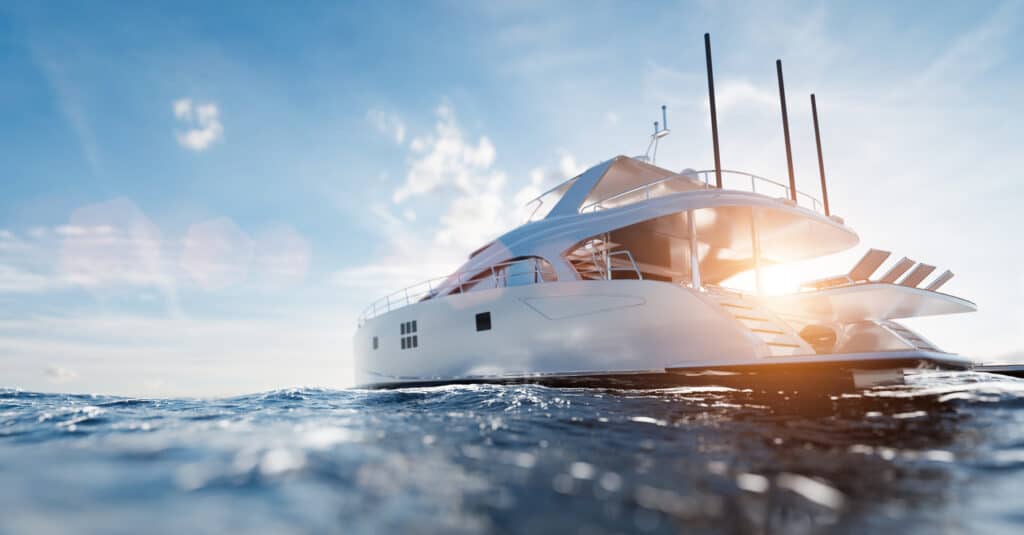
The modern catamaran is far more different than its crude ancestor. Instead of tree cutouts, catamarans are now carbon fiber or fiberglass. Here are the different types of catamarans:

Based On function
Pontoons are usually present on rivers and lakes and sometimes even on oceans, but they only travel near the shore.
In a catamaran pontoon-type boat, the pontoons serve as storage areas, where you will find the onboard motors. They are useful for water leisure activities such as short water trips, tubing, wakeboarding, and water skiing.
Some pontoons may also serve as houseboats. They provide a broader, more stable platform ideal for a floating house. Plus, the space is bigger, and most of it is above water. It offers a better viewing option than a monohull. ( Source )
Small Waterplane Area Twin Hull is a catamaran-type boat that the United States Navy initially used for military purposes. They provide the water stability that is necessary when transporting heavy military equipment.
One example of a military SWATH catamaran is the Spearhead class EPF. It is as long as a World War II escort destroyer, yet it is twice as fast at 43 knots. It can reach that speed because of its two separate hulls.
Because of their innate speed, SWATH catamarans can become patrol boats in lakes and rivers. They can easily outrun and outmaneuver standard watercraft.
Nowadays, there are SWATH cruise ships and other non-military variations. ( Source )

Based On Design
- Sailing Catamaran
The smaller sailing catamarans do not have auxiliary engines, so the owner can propel the boat by harnessing the wind using the sails. It’s a popular choice for people with very little or no sailing experience because they are light and easy to use.
The larger sailing catamarans are for group charters and long-distance cruising. They have become so popular lately that they now outnumber monohulls in tropical locations all over the world. They have a last, a headsail, and a mainsail. And the twin hulls have one engine each.
- Power Catamaran
Unlike their sailing cousins, the powered catamarans do not have sails. They have massive engines which provide high speed. Their twin hulls are stronger and can carry and protect the large motors.
The smaller “powercats” are used mainly for fishing. The bigger ones are rented out for charters and cruises.
Catamaran Hulls Performance
Thanks to the catamaran hulls, the boat offers many advantages over other boat types.
- Because its dual-hull design provides a broader base, it offers more water stability than monohull boats. It makes the cat (catamaran) a popular choice for fishing expeditions and cruises.
- Riding a catamaran is ideal for people who feel seasick whenever they ride boats. The twin hulls prevent the boat from moving from side to side. The hulls allow the boat to travel smoothly, even on moderately choppy waters.
- The catamaran is the best choice when storing provisions and other household items with less heeling and bobbing.
- The twin hulls’ stability is ideal for many activities such as cooking and partying.
- Cats offer more moving space because of their broader base, thanks to dual hulls.
- With a catamaran, you have two great options on where to hang out. You can do it on the spacious deck or below the galley.
- Compared to a monohull of the same size, the catamaran can accommodate more equipment and people.
- The living area in a catamaran is above the water line. This feature provides more natural light, a greater view of the outside, and better air circulation.
- Since catamarans do not have keels, they can anchor on shallow waters, something that most monohulls will not be able to do. This ability of catamaran boats is impressive, especially if you are going around areas with many reefs and small islands.
- Catamaran hulls allow the boat to cut through the waves easier and faster. It means they require less engine power than their monohull counterparts.
- Because it has two engines and two rudders, the catamaran can easily maneuver in very tight spaces.
- Because they do not carry heavy keels, catamarans can sail faster than monohulls.
- The catamaran’s stability, speed, and weight make it a safer option than the monohull. It can sail in shallow waters, make a 360 degrees maneuver effortlessly, and carry more provisions.
Disadvantages Of A Catamaran
Like any other boat type, the catamaran also has drawbacks and limitations. Here are some of them:
- The catamaran hulls prevent the boat from sailing as fast as the monohull upwind. The two hulls cause drag, and this slows the boat considerably.
- Because of its bigger size, looking for a docking site can be more difficult and costlier than a monohull.
- For hardcore sailing fans, the experience of sailing with a catamaran will never be able to match that of sailing with a monohull. To them, the challenge of true sailing is just not there with a catamaran.
What Are The Hulls Of The Catamaran Called?
According to the Online Etymology Dictionary, the Tamil word கட்டுமரம், which is pronounced as kattumaran, is where the word catamaran takes its name. The word means “pieces of logs tied together”. Through the years, the term has evolved into what is now a catamaran in English.

What Are The Characteristics Of A Catamaran Hull?
- Both hulls of a catamaran complement each other to achieve very minimum water resistance.
- Because of this, it takes less energy to propel a catamaran, whether via an engine or sails.
- The catamaran hulls provide stability to the boat. The twin-hull significantly reduces bobbing.
- The catamaran’s ability to keep steady on the water makes it an ideal vessel for cooking, dining, and storing provisions.
Are Catamarans Good In Rough Water?
Catamarans are amazingly stable in rough water. The catamaran’s design and build, which provides stability, are factors why it is one of the best boats to use when the waters are choppy.
Yes, catamarans are relatively more expensive than monohulls. Nevertheless, since single-hull boats are less expensive, their resale value is also cheap.
If you add all the advantages that a catamaran offers – safety, comfort, and speed- it does not come out expensive.
patekphilippe.io

Share this post with your friends
Subscribe to our newsletter.
Join us in our love for all things water. And Adventure.

Can You Use A Bass Boat In Saltwater?
Advertisement Bass boat in saltwater? Really? Going fishing on a fine sunny day might come to your mind. However, you only have a bass boat as your best companion. It leaves you to question if you can use your boat in saltwater? Saltwater contains a tremendous amount of salt, as the name suggests. This salt

Are Kevlar Canoes Worth It? (A Kevlar Canoe Owner’s Advice)
Advertisement When you’re on the hunt for either your first canoe or a replacement canoe, research will always lead you to the question of what material is best. Canoes typically come composed of fiberglass, plastic, wood, kevlar, aluminum, canvas (over a frame), or other synthetic fiber composite materials. Any canoeist worth their salt will mention

Should You Paint Or Re-Gelcoat A Boat Hull?
Advertisement A regularly waxed gelcoat can last for up to 15 years on the boat. This figure can vary based on how well you take care of your boat’s hull. If you’re having trouble deciding whether to re-gelcoat or paint the hull, here’s a fantastic guide for you (and your boat). It is safe to

Pontoon Boat Basics
Heading out to the lake? Well, there’s no better way to enjoy the day than from your pontoon boat. Imagine the fun you’ll have with family and friends cruising around in the sunshine. Even if you’re a novice, a pontoon boat is easy enough to maneuver.

Can You Wakeboard Behind A Bass Boat?
Can you wakeboard behind a bass boat? Find all the answers here from wakeboard requirements to bass boat abilities.

The Complete Guide To Replacing Boat Flooring
Advertisement Now that you’ve decided replacing boat flooring is the way to go, it’s always a good idea to take the help of some excellent and valuable guides. You can hire a professional to redo your boat flooring as several professionals in the market can do the job at a reasonable price. On the other

Boat Information By Type
© 2023 Boating.Guide, A Hyperwave Media Group Ltd. Publication.
Privacy Overview

The 8 Main Characteristics of a Catamaran Hull
Posted on May 28, 2022
Ever wonder why your catamaran ride is so much smoother than other boats, including yachts? Why don’t I get as oozy as when I’m on other vessels, even when the water is choppy?
It’s all about the hull, my fellow water enthusiasts. Not just one but two hulls, positioned in such a way as to give us the most perfect ride we can get on the ocean, without us having to grow fins.
Catamarans have a wide beam, instead of a ballasted keel like a monohull vessel, which provides its steadiness. It has a more shallow draft and smaller displacement than a monohull with a similar length. Its hull offers stability, more space, privacy, no heeling, lower hydrodynamic resistance, and more.
Now that you’ve gotten the gist of it, let’s look in-depth at the hull characteristics.

1. Lower Hydrodynamic Resistance
Hydrodynamic resistance of the combined two hulls is usually lower than equivalent monohulls, needing less power from the sails or the engines. A catamaran’s broader posture on the water can decrease the feeling.
It also lessens the motions caused by waves, which can also produce smaller wakes than on a single-hulled vessel.
A cat’s hulls have a less wetted surface area, which means they burn less fuel. The boat may be propelled by one engine in mild winds.
2. Reduced Heeling

The term “heeling” refers to the tendency of a sailboat to lean to one side due to the force of the wind on its sails. The boat is oriented so that the wind hits the sails at an angle and pushes them to one side of the boat, propelling the boat.
Catamarans are the safest way to navigate the oceans because they have no heel angle. Cruising catamarans are safer than monohulls for their crew because they offer better protection and a no-heel environment.
As a result, the crew will be less exposed, make fewer mistakes due to exhaustion, and arrive at their destination more rested.
3. Less Displacement
Boats that employ buoyancy to support their weight are referred to as displacement hulls. To provide its name, it is partially immersed and moves by causing water to be dislodged.
Its weight is equal to the amount of water it dispenses. In stormy water, it maintains its sturdiness. As a result, cruisers and sailboats alike frequently make use of this design.
4. Stability

In place to evade capsizing as well as heeling, the catamaran depends on hull stability, while hull stability depends on buoyancy and beam. About half of a typical cruising catamaran’s length is its beam.
Say, for example, that the boat was 50 feet in length, the beam might be about 25 feet broad so that you could maintain the balance between heel and righting moment.
On a cat, passengers who are prone to motion sickness will be far less affected by the impacts of motion than they would be on a monohull. The cook’s task is made much easier while traveling and at anchor because of the cat’s extra stability. When compared to monohulls, catamarans have less rock and roll.
Once you’ve decided to sail, you won’t have to worry about scrambling to stow things or securing them with bungee cords. Relatively rough seas have little effect on most of the ship’s equipment.
5. A Bridgedeck Connects Them

You can’t ignore this reality! Bridgedeck clearance, or the gap between the water and the bridge deck, is an important factor in a catamaran’s safety and reliability. Ocean waves have room to flow between the hulls thanks to the bridge deck clearance.
Our catamaran’s hulls create waves that converge underneath the bridge deck, requiring a larger buffer for the bridge.
If you don’t have enough clearance, your catamaran will be pounded by the waves.
In addition to slowing your catamaran down by 3 to 4 knots, rough seas can also put your guests’ health and safety at risk, as well as inflict significant damage to your boat and rigging.
6. Can Maneuver Shallow Water
A boat’s draft is the distance from the water’s edge to the hull’s center of gravity. It is important to know the depth of a boat’s draft since it determines the quantity of water that can be displaced for safe passage. As a result of their parallel hulls’ buoyancy, catamaran vessels can have fewer drafts without affecting their stability or their ability to maneuver.
When it comes to hull stability and handling, monohull vessels are built with a deeper draft to protect against capsizing as well as heeling. Because of this, the catamaran was deemed suitable for use in shallow waters.
Boating activities such as swimming and fishing aren’t the only ones that benefit from being able to dock in shallow water. A boat with a shallow draft will be more maneuverable in areas where you may have to sail through a variety of shallow areas, some more than others.
Monohull boats with deeper drafts may be unable to access shores, intertidal zones, coral reefs, or even sandbars because of their shallower depths. Also, shallow-water swimming and snorkeling are two of the most popular pastimes for sailors plus their families. To ensure a smooth experience, you’ll need secure access to shallow waters.
There are several types of fishing that require a catamaran’s dependability and readiness, and these include trout, oystering, and clamming. These activities become much easier when you can navigate shallow waters without worrying about running aground or striking underwater objects.
7. Allows Cat to Have More Space
It certainly does. Eating and preparing food can be done side by side. One hull is used as a big cabin in the “owner versions,” which are fantastic for parties.
Most comparable-priced monohulls lack the amount of interior room seen on catamarans, especially in the primary salon, galley, plus cockpit. As a result, their cabins tend to be larger, and now even the tiniest cat in the group has a stand-up headroom in each one.
8. Offer More Privacy
The distance between the two hulls allows for greater privacy than on monohull yachts, which tend to be closer together.
Because of the configuration, a cat offers more solitude than monohulls, and the increased separation between the main living area and the cabins makes it simpler for children to go off to sleep at a normal hour when aboard.
What Are the Differences Between Catamaran and Monohull Sailing?

Most characteristics of sailing a catamaran resemble those of sailing a monohull. In most Catamaran Sailing Boats, the abilities you acquire on a monohull, you can transfer to a cat. A few minor distinctions must be made though, including these.
Keep a steady speed during the tack to avoid “winning,” which can occur if you relax the mainsheet too much. Winning occurs when a catamaran’s larger mainsail tries to direct the boat towards the direction of the wind.
Gybing on the monohull necessitates much more caution, therefore you have to slow down your gybe considerably. Travelers on catamaran boats have an advantage since they can sustain a pace while gybing to depower the main.
You can tell when you’ve got too much sail on a monohull by the way the boat is heeling, which tells you it’s time to reef. Since catamarans don’t heel, we have to be super cautious when reefing the enormous mainsail because it’s so heavy.
In most cases, the first reef will be thrown in between wind speeds of 18 and 20 knots (determined by the size of our yacht) and the second reef will be thrown in as the wind speeds reach up to 25 knots.
Many elements of sailing a catamaran are fairly similar to those of a monohull, so making the switch should not be too difficult.
Are Catamarans Safer Than Monohulls?

Exactly what I was looking for! People are less likely to drown when sailing on a catamaran than on a monohull, thanks to the boat’s greater stability. They are bigger, more steady vessels. In most cases, this makes cats “safer” than a monohull of the same size.
Having two engines makes catamarans “safer” in the event of an engine breakdown. Sailing is the sole alternative on a monohull boat if the motor is out of commission. In the event of an emergency, the second engine on a catamaran is always ready to assist!
Is Sailing A Catamaran Easier Than Sailing A Monohull?
It is more difficult to sail a monohull because of heeling and the constrained space it has to offer. In greater gusts, monohulls heel, making it harder to accomplish most activities.
Sailing aboard a heeling vessel is more difficult for a variety of reasons, including heading forward to a reef, having to haul in a sail, or just moving around the boat.
The greater stability and space provided by catamarans, on the other hand, make moving around the boat easier than on other types of boats. The fact that catamarans are typically referred to as “easier” to sail is due to this.
- 2024 BOAT BUYERS GUIDE
- MIAMI BOAT SHOW
- Email Newsletters
- Fishing Boat Reviews
- Fly Fishing
- Marine Electronics
- Fishing Tackle
- Best Marine Electronics & Technology
- Fishing Destinations
- The Bahamas Fishing Guide
- Boating Safety

2023 Boat Buyers Guide: Catamarans
- By Karl Anderson
- December 27, 2022
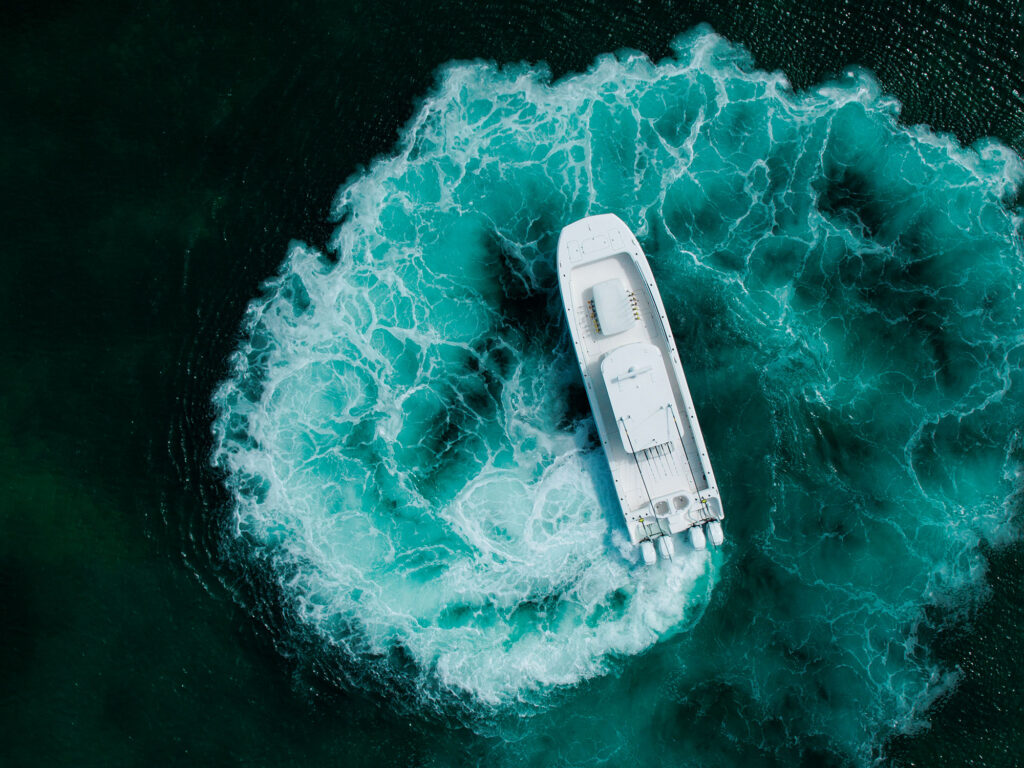
The popularity of the multihull (aka catamaran or cat) fishing boats has never been greater, as more and more boatbuilders enter this growing segment of the market. The inherent stability of the catamaran design rolls less with the seas, making fishing offshore less tiresome and more comfortable. Available from 20 to 48 feet, catamarans typically offer a large fishing platform with generous storage and fishing amenities. They are available in a wide variety of deck layouts, including center-consoles, dual-consoles, and even pilothouse and express variants.
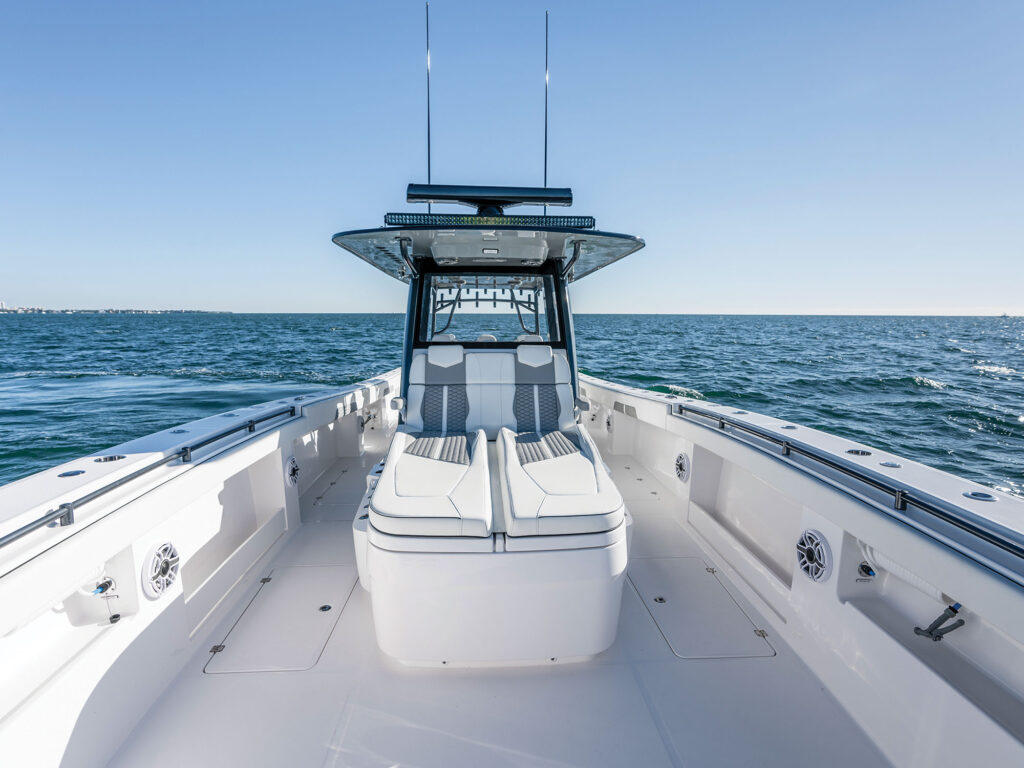
Big Picture
The large deck area of a catamaran enables many large underdeck storage lockers and insulated fish boxes in the sponsons. This gives anglers ample room for gear and the day’s catch. The catamaran’s stability, fishability, and smooth ride in rough seas make it attractive to anglers as well as day-cruisers. A center-console version adds 360 degrees of angler access to the rail. With the dual-console design, generous seating behind a beam-to-beam windshield makes for a great family fishing-friendly setup.
Live bait is one of the most popular types of fishing in virtually every coastal zone. To do it successfully requires optimal water capacity and proper flow. The minimum size of the outflow water plumbing should be twice the size of the inflow. The plumbing should have a drain at the bottom to shed scales at the end of the day, as well as a drain at the top of the well to adjust capacity and allow overflow. Above-deck transom-mounted wells should fully flood to the lids when running to keep baits from getting beat up.
Tip: A sump box with multiple pumps in case a pump fails is the best setup for first-rate livewells. Conveniently located inflow and outflow valves make it easy to optimize the flow without tiring your bait from swimming too much in the well.
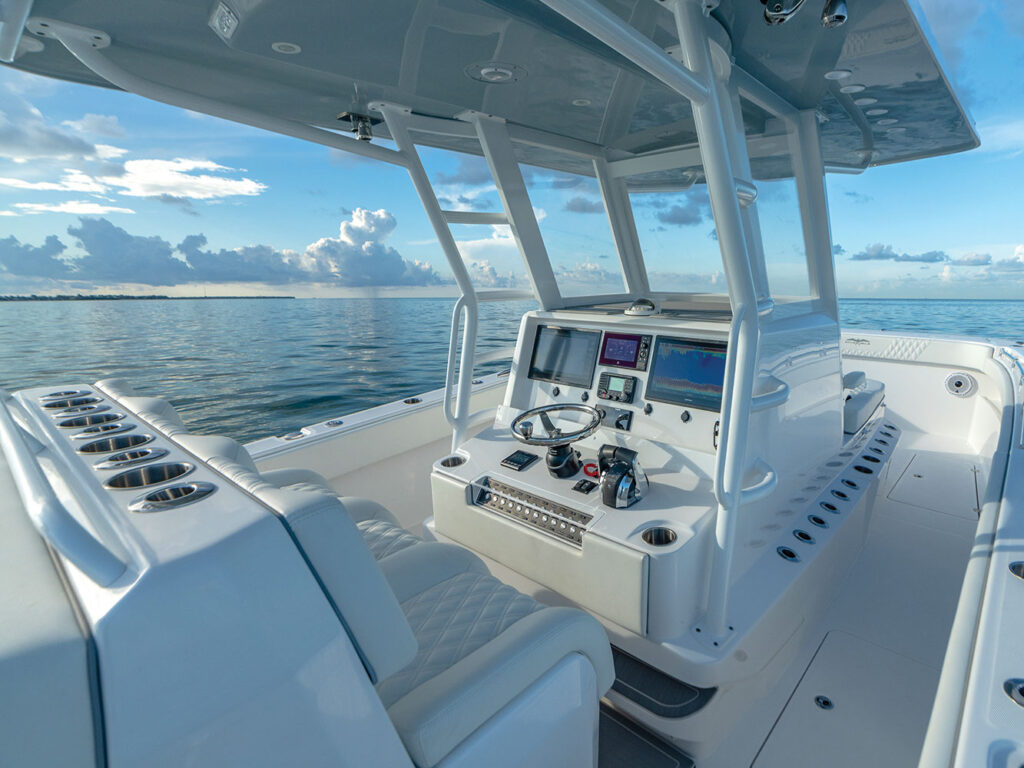
Rod Storage
Having enough rod holders is essential to be successful for opportunity fishing. Look for vertical rod storage along the console and across the back of the T-top. Many models also have rod holders along the outboard transom wall. Having plenty of gunwale rod holders for drift- and kite-fishing is helpful.
Tip: Placing adjustable swivel rod holders by Gemlux makes deep-dropping, lure-fishing and drifting even easier because they allow your rods to face the direction the baits are fishing, yet they can be swiveled back to keep rods from sticking out of the boat while running and docking.
Manufacturers often offer multiple choices for horsepower, but whatever the choice, the engines must come in pairs. For example, you might order twin outboards (one for each sponson) or four outboards (two for each sponson), but single- or triple-outboard configurations are not common on a cat. Optimal selection should be made based on user load, weight of the boat, ride comfort , performance desires, and best case for resale. It’s a rare day when you can run wide open, but having more horsepower gives better torque at slower speeds and thus better control. Running larger engines slower gives better fuel efficiency too.
Tip: When possible, choose the highest horsepower offered because it typically leads to a better resale value with a shorter sales cycle.
Power steering from engine manufacturer Optimus or SeaStar is essential with the higher horsepower required for larger boats, and it makes installing and operating the upper station in a tower far more practical and comfortable.
With the power demands of electronics, livewell pumps, stereo amps and more, it is wise to have at least two house batteries, and for larger boats, a third or fourth with a multibank charger for dockside. Each engine should have its own dedicated battery as well.
Electronics
Typically choosing the largest screen or multiple screens that will fit on the console is best-case scenario for ease of use, ergonomics, and visibility. VHF radios, stereo controller, and equipment switches for lighting, pumps, and accessories should all be integrated with greatest visibility and ease of operator reach.
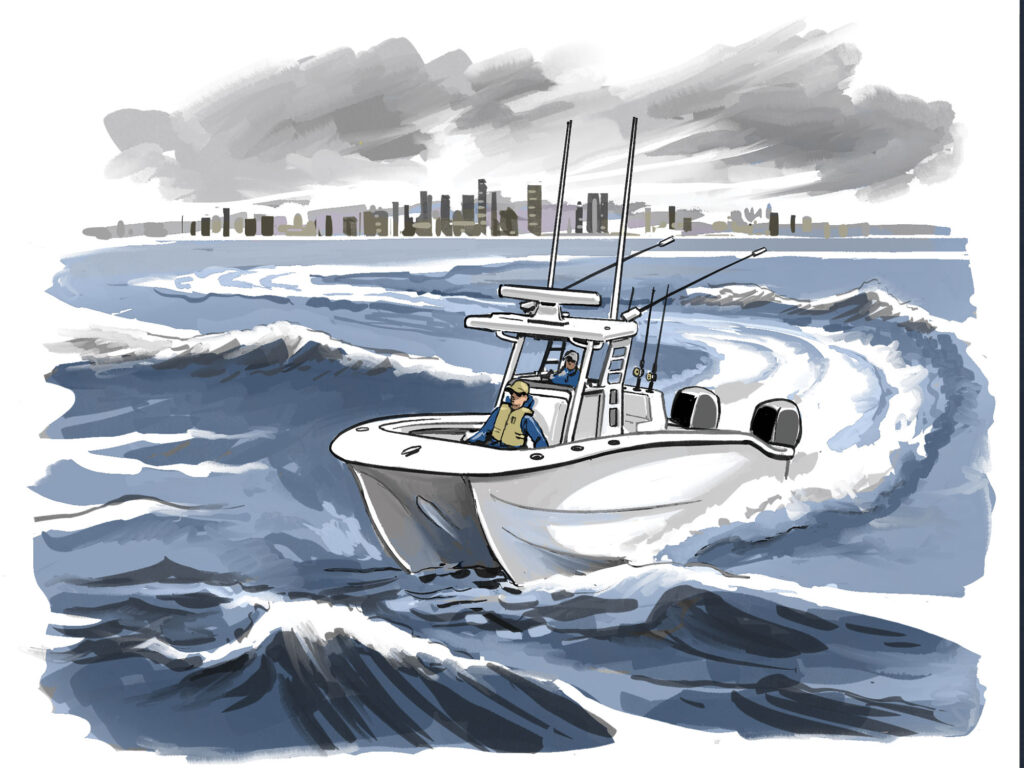
A Tale of Two Hulls
A catamaran rides on pair of hulls, or sponsons, each thinner and sharper than that of a similarly sized monohull boat. The narrow sponsons of the cat tend to slice easily through water to deliver a smooth ride, even in rough seas. At the same time, with the sponsons positioned out to the sides of the boat, cats tend to roll less, thus providing great stability to enhance crew comfort, security and safety. However, cats tend to corner more flatly than a monohull, and some hulls (but not all) tend to lean outward versus inward during a turn.
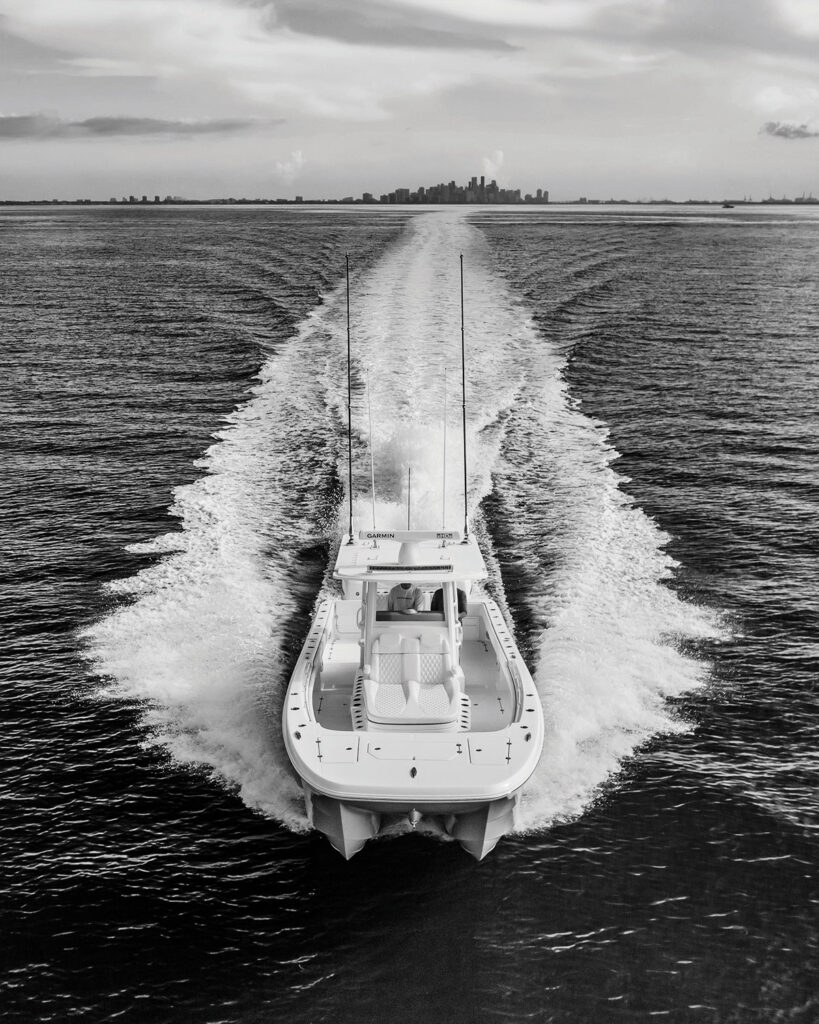
Experts Say
Newer designs such as Invincible’s Morelli and Melvin-designed semi-asymmetrical sponsons eliminate some of the negatives of the cat design, such as “sneezing,” where water sprays out the front of the boat when hitting a wave. They’ve also controlled the uncomfortable “outboard lean” sensation common in older designs when in a turn. Once transitioned to a catamaran, many become true believers and preach the benefits of the design.
Editor Says: Saltwater fishing cats not only offer superb stability and smooth ride, but some also display exceptional speed and range. I recall one trip out of Key West, Florida, aboard an Invincible 40 Cat with four 350 hp outboards to the Dry Tortugas. It was a 60-mile run, and we made it there in 70 minutes. We caught more fish than our arms could bear, and then dashed back to Key West, arriving in time for cocktail hour on the same day. -Jim Hendricks, Staff Editor, Boating and Fishing Group
- More: 2023 Boat Buyers Guide: More Resources , Boats
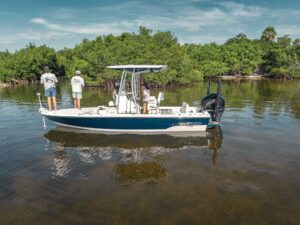
Pathfinder 2200 TRS
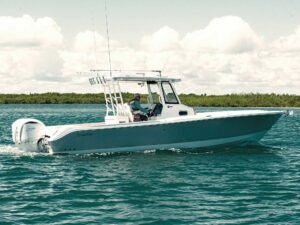
EdgeWater 325CC
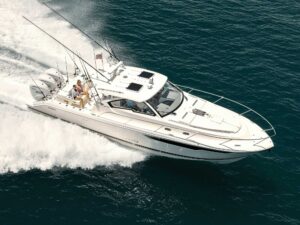
Pursuit OS 405 Offshore
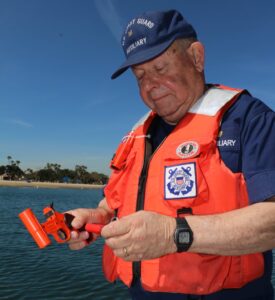
Prepare for Launch: The Springtime Vessel Safety Checklist
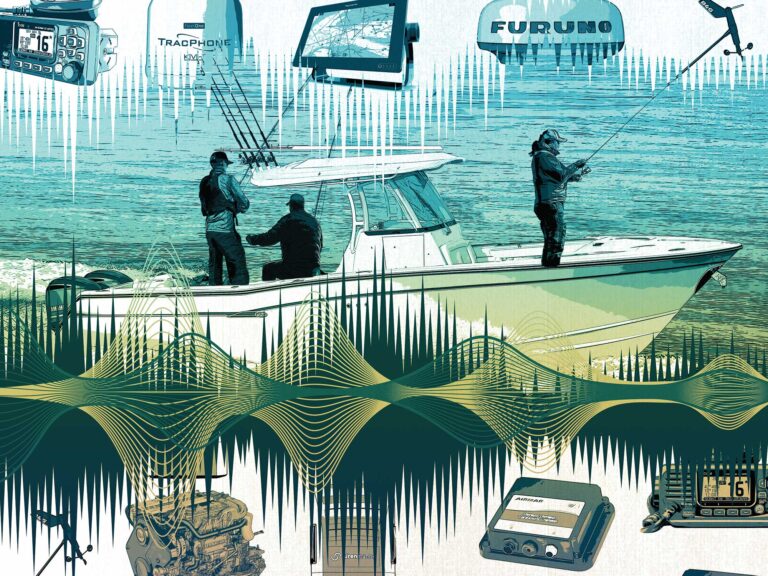
What Can Boating Anglers Expect From NMEA OneNet?
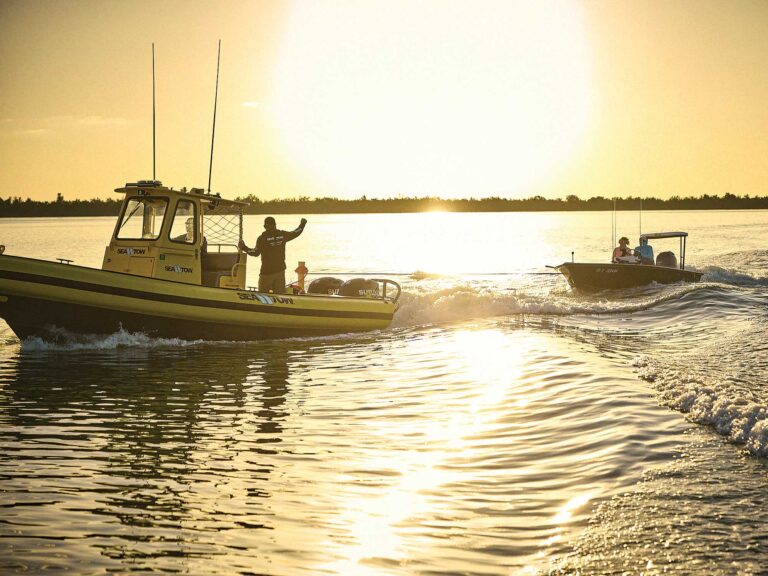
10 Common Solutions for Boat Engine Problems
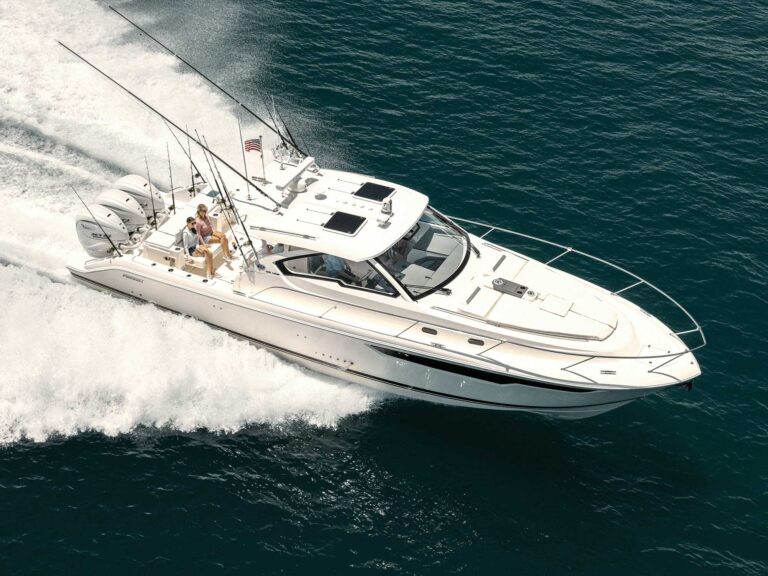
Where’s the Data for Making Changes to California’s Halibut Regulations?

- Digital Edition
- Customer Service
- Privacy Policy
- Cruising World
- Sailing World
- Salt Water Sportsman
- Sport Fishing
- Wakeboarding
ScienceSphere.blog
Exploring The Key Characteristic Of A Catamaran Hull: Unveiling Its Secrets

Table of Contents
Brief explanation of what a catamaran hull is
A catamaran hull is a type of boat hull that consists of two parallel hulls, known as pontoons, connected by a deck or platform. This design provides stability and balance, making catamarans popular for various water activities, including sailing, cruising, and racing.
Importance of understanding the key characteristics of a catamaran hull
Understanding the key characteristics of a catamaran hull is essential for anyone interested in owning or operating a catamaran. These characteristics play a significant role in the performance, safety, and comfort of the vessel. By familiarizing oneself with the unique features of a catamaran hull, enthusiasts can make informed decisions and fully enjoy the benefits of this type of boat.
Catamarans have gained popularity in recent years due to their numerous advantages over traditional monohull boats. They offer increased stability, speed, and living space, making them an attractive choice for both recreational and professional use. However, to fully appreciate these benefits, it is crucial to delve into the key characteristics that make catamaran hulls stand out.
In the following sections, we will explore what a catamaran hull is, its basic structure, and how it compares to other types of hulls. We will also discuss the advantages and disadvantages of a catamaran hull, as well as the key characteristics that make it unique. Finally, we will uncover some of the secrets behind the design, construction, and maintenance of a catamaran hull. So, let’s dive in and discover the fascinating world of catamaran hulls!
What is a Catamaran Hull?
A catamaran hull is a type of hull design that consists of two parallel hulls connected by a deck or a bridge. Unlike a monohull, which has a single hull, or a trimaran, which has three hulls, a catamaran offers unique advantages and characteristics that make it a popular choice among boating enthusiasts.
Definition and basic structure of a catamaran hull
A catamaran hull is typically characterized by its twin hulls, which are symmetrical and separated by a wide beam. These hulls are connected by a deck or a bridge, providing stability and balance to the vessel. The design of a catamaran hull allows for increased buoyancy and reduced drag, resulting in improved speed and performance on the water.
Comparison to other types of hulls (monohull, trimaran)
When comparing a catamaran hull to other types of hulls, such as a monohull or a trimaran, there are distinct differences. A monohull has a single hull, which can make it more prone to rolling motion and less stable in rough waters. On the other hand, a trimaran has three hulls, which can provide additional stability but may sacrifice some speed and maneuverability.
A catamaran hull strikes a balance between stability and performance. The twin hulls of a catamaran provide excellent stability, reducing rolling motion and making it more comfortable for passengers. Additionally, the wide beam of a catamaran hull offers ample deck space, allowing for a spacious and comfortable living area.
Advantages and disadvantages of a catamaran hull
Catamaran hulls offer several advantages over other types of hulls. One of the key advantages is their stability. The twin hulls provide a wide base, making catamarans less prone to tipping or rolling. This stability makes catamarans an excellent choice for those who may experience seasickness or prefer a smoother ride.
Another advantage of a catamaran hull is its speed and performance. The design of a catamaran reduces drag, allowing it to glide through the water more efficiently. This increased efficiency translates to higher speeds and better fuel economy compared to other hull types. Additionally, the shallow draft of a catamaran hull enables it to navigate in shallower waters, opening up more cruising destinations.
However, it is important to consider the disadvantages of a catamaran hull as well. Catamarans can be more expensive to purchase and maintain compared to monohulls. The twin hulls require additional materials and construction techniques, which can increase the cost. Additionally, catamarans may require more maintenance due to their larger size and complex systems.
In conclusion, a catamaran hull is a unique and versatile hull design that offers numerous advantages for boating enthusiasts. Its stability, speed, and spacious living areas make it an attractive choice for those seeking comfort and performance on the water. However, it is essential to weigh the advantages and disadvantages before making a decision. Understanding the key characteristics of a catamaran hull is crucial for anyone considering purchasing or sailing on a catamaran.
Key Characteristics of a Catamaran Hull
A catamaran hull is a unique type of hull that offers several key characteristics that set it apart from other types of hulls, such as monohulls and trimarans. Understanding these characteristics is important for catamaran enthusiasts as it can greatly impact the performance, comfort, and overall experience of sailing on a catamaran.
Stability and Balance
One of the primary advantages of a catamaran hull is its exceptional stability and balance. This is achieved through its wide beam and twin hulls. The wide beam provides a solid foundation, allowing the catamaran to remain stable even in rough waters. The twin hulls further enhance stability by distributing the weight evenly, reducing the risk of capsizing.
Additionally, the design of a catamaran hull significantly reduces rolling motion. Unlike monohulls, which tend to roll from side to side, catamarans have a minimal rolling motion. This makes them more comfortable to sail on, especially for those who are prone to seasickness.
Speed and Performance
Catamaran hulls are known for their impressive speed and performance. The design of the hull reduces drag, allowing the catamaran to glide through the water with ease. This increased efficiency translates into higher speeds and improved fuel economy.
Another advantage of a catamaran hull is its ability to sail in shallow waters. The twin hulls are positioned higher above the waterline compared to monohulls, which reduces the risk of running aground. This opens up a wider range of sailing destinations, including shallow bays and coastal areas that may be inaccessible to other types of boats.
Living Space and Comfort
Catamaran hulls offer generous living space and enhanced comfort compared to other types of hulls. The spacious interior layout provides ample room for living, dining, and sleeping areas. This is particularly beneficial for those who plan to spend extended periods of time on their catamaran, such as liveaboards or long-distance cruisers.
Furthermore, the twin hulls of a catamaran provide enhanced privacy and separate living areas. Each hull can be dedicated to specific functions, such as bedrooms, bathrooms, or storage spaces. This allows for greater privacy and comfort, especially when sailing with a group or family.
In conclusion, understanding the key characteristics of a catamaran hull is essential for catamaran enthusiasts. The stability and balance, speed and performance, as well as the living space and comfort offered by a catamaran hull, make it a popular choice among sailors. Whether you are a seasoned sailor or a beginner, exploring and experiencing the secrets of a catamaran hull can greatly enhance your sailing adventures. So, set sail and discover the joys of sailing on a catamaran!
Secrets of a Catamaran Hull
A catamaran hull is a unique and innovative design that offers numerous advantages over traditional monohull or trimaran hulls. To fully appreciate the benefits of a catamaran hull, it is essential to understand the secrets behind its design, construction, and maintenance.
Design considerations
Hull shape and profile : The shape and profile of a catamaran hull play a crucial role in its performance and stability. The hulls are typically wider than those of monohulls, providing a larger surface area for buoyancy and stability. The streamlined shape reduces drag and enhances speed, making catamarans faster and more efficient.
Weight distribution and center of gravity : Proper weight distribution is vital for maintaining balance and stability. The weight of the catamaran is evenly distributed between the twin hulls, ensuring a low center of gravity. This design feature minimizes the risk of capsizing and enhances the overall stability of the vessel.
Construction materials and techniques
Fiberglass, aluminum, or composite materials : Catamaran hulls are constructed using various materials, including fiberglass, aluminum, or composite materials. Each material has its own advantages and considerations, such as durability, weight, and cost. Fiberglass is a popular choice due to its strength, flexibility, and resistance to corrosion.
Importance of structural integrity : The structural integrity of a catamaran hull is of utmost importance to ensure its longevity and safety. The hull must be built to withstand the forces of the water and the stresses of sailing. Reinforcements, such as bulkheads and stringers, are strategically placed to provide additional strength and rigidity.
Maintenance and care
Regular inspections and repairs : To keep a catamaran hull in optimal condition, regular inspections and maintenance are necessary. This includes checking for any signs of damage, such as cracks or delamination, and promptly addressing them. Regular cleaning and antifouling treatments are also essential to prevent the buildup of marine growth and maintain the hull’s performance.
Protecting against osmosis and corrosion : Catamaran hulls are exposed to the harsh marine environment, making them susceptible to osmosis and corrosion. Osmosis occurs when water penetrates the hull, causing blistering and delamination. Applying protective coatings and maintaining a proper barrier system can help prevent osmosis. Additionally, using corrosion-resistant materials and implementing proper cathodic protection systems can minimize the risk of corrosion.
Understanding these secrets of a catamaran hull is crucial for catamaran enthusiasts and owners. By grasping the design considerations, construction techniques, and maintenance requirements, they can make informed decisions when purchasing or maintaining a catamaran. These secrets not only enhance the performance and longevity of the vessel but also contribute to a safer and more enjoyable sailing experience.
In conclusion, the secrets of a catamaran hull lie in its design, construction, and maintenance. The unique hull shape, weight distribution, and choice of materials contribute to its stability, speed, and comfort. Regular inspections, repairs, and protective measures are essential to ensure the hull’s longevity and performance. By understanding and appreciating these secrets, catamaran enthusiasts can fully embrace the advantages of this remarkable vessel and embark on unforgettable sailing adventures.
Decoding Racial Triangulation: Unveiling Its Impact On English Language
Decoding The P Vs. Q Inventory Systems: Unveiling The Key Differences
Unveiling The Mystery: What Is Milk Whitener And How Does It Work?
Decoding The Mystery: What Exactly Is A Dna Size Standard?
Unveiling The Secrets: What Is Hearth Bread And Why It’s A Must-Try
Decoding The Mystery: What Time Is 22 32 In English Language?
Decoding Labor Demand: Unveiling The Elasticity Mystery
Demystifying Abrams Law: Understanding Its Impact In English Language
Curiosity Bites: What Happens If You Eat Concrete?
Decoding The Sexual Slang: What Does “Hh” Mean?
Leave a Comment Cancel reply
Save my name, email, and website in this browser for the next time I comment.
- PERFORMANCE TOPICS
Optimising Hull Lines for Performance
This article was inspired by a question about the rocker line in the new 8.5m cat Design 256 and I want to stick to the point, so we won’t turn it into a book, but I’ll discuss two issues, hull fineness ratio and some aspects of the rocker profile.
When you manipulate the hull form you’re adjusting the lines in three planes, waterplanes (plan view), buttocks (side view including the keel rocker) and the section shapes. So you need to be aware of how the shapes are changing in the other two planes as you manipulate any one of these three, or all three globally as is now possible with computer modelling.
There are two fundamental constants that you start with and don’t change throughout the process. The big one is the displacement or the amount of buoyancy you need.
If you make the hull finer by narrowing the waterlines you have to increase the draft or make the ends fuller to get back to the required displacement number.
If you flatten the rocker line you have to increase the hull width, fill out the ends, or square up the section shapes rather than having a V or rounded V.
The other constant is the longitudinal centre of buoyancy. You really can’t do any meaningful shaping of the hull form until you have settled on the these two constants.
A third number that we can plug in as a constant if we want to is the prismatic coefficient which describes bow much volume there is end the ends relative to the cross section shape in the middle of the boat, but in sailing boats this is of less importance compared to other factors.
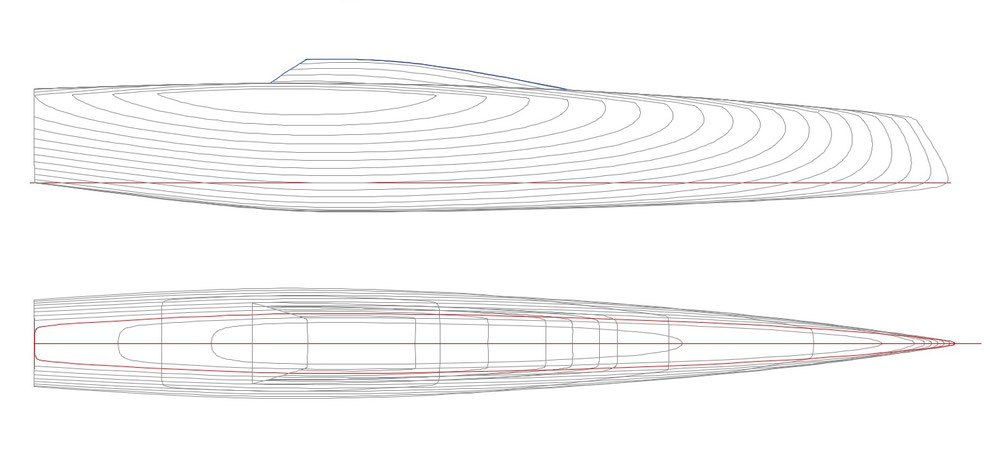
The hull lines for Design 256, 8.5m Cat. It's that hump in the rocker line - right under the back of the cabin that brought up the question and is one of the key points discussed here.
Hull fineness.
Fine hulls are fast, but only in the higher speed range. There’s a misconception I come across quite a bit that you can add weight and windage and you’ll still be fast as long as your hulls are fine.
Well you won’t be. Your boat will simply sink to find the new state of equilibrium. If your transoms are submerged you’ll have more drag. If your bridge deck is too close to the water you’ll have slamming. Much better to be conservative with your displacement figure in the design stage than overly optimistic.
And fine hulls have more wetted area so you have more drag in light air where friction resistance is the primary drag factor.
I’ve seen promotional material for catamarans stating that the boat has less wetted area because it has fine hulls. For a given displacement the minimum wetted area is described by a sphere (or a semi sphere in the case of a floating object). The more you stretch it out in length, keeping the displacement constant, the more wetted area you have.
The more you make the section shape into a deep V or a broad U with tight corners, as opposed to a semicircle, the more wetted area you have. Add into the equation finer hulls are slower to tack.
So fine hulls are only an advantage if your boat is light and has enough sail area to ensure you’re travelling at speeds where form resistance is greater than skin resistance.
In my view the advantage of fine hulls is often overrated as it applies to cruising cats.
At the other end of the scale the resistance curve is fairly flat up to about 1:9 which is still quite fast in most conditions. From there the resistance rises steeply as the hull gets fatter and at 1:8 and fatter you’re suffering from some serious form drag.

This is the rocker line isolated from the lines plan above (in blue) and and the red line shows a more moderate rocker line that achieves the same buoyancy and maintains the centre of buoyancy in the same position. The bow is to the right.
In the image lower right I've squashed it up and increased the height to make the difference in the lines more obvious.
The difference in the two lines is quite subtle, but races are often won or lost by seconds.
Rocker Profile
So if we’re looking for low wetted area we would want a rocker profile that was even and rounded, relatively deep in the middle and rising smoothly to the surface at each end. But this would give us a low prismatic which is not ideal in the higher speed range, and it’s not ideal for pitch damping which in my view is the critical design factor that is often underrated.
Pitching is slow. It destroys the airflow in your sails and the flow around the hulls, and your performance is suffering from slamming loads.
The single most effective way to counter pitching is with asymmetry in the water planes. You can achieve that in the with a fine bow and broad transom. Or you can achieve it with V sections forward and a flattened U shape aft. Or you can achieve it in the profile view with a very straight run forward and a bump in the aft sections. A flatter rocker line is better for resisting pitching than an evenly curved one with deeper draft in the middle.
The final result is a combination of all three of these factors.
On a cat like Design 256 the weight is concentrated well aft so we need to get buoyancy well aft.
The kink you see in the rocker profile helps to do this. It also helps to keep the rocker straight for most of its length and smooth the water flow exiting the hull aft at higher speeds, possibly promoting some planing effect.
If we had a more even rocker line we would slightly reduce the wetted area, but we would increase the pitching and the water would exit the hull aft at a steeper angle, increasing form drag in the higher speed range.
How much of a bump can you put in there without creating a flow separation, and how damaging would that flow separation be? I really don’t know. The way all of these factors interplay in the various conditions we sail in is very complex.
Ultimately a lot of this work is gut feel nurtured by experience, observing things in nature and most importantly experimenting and trying new ideas.
Is the new Groupama AC45 a breakthrough that will influence the form of racing catamarans into the future? I don’t think anyone has a computer that can answer that. We have to wait and see.

Symmetric and non symmetric water-planes. The blue line with grey fill is the DWL from the design above. As is typical with modern cat hulls the bow is long and fine, the stern is full and rounded. This is the asymmetry that has a damping effect on pitching. The red line on the other hand is more like you would see on a double ended monohull and quite a few multihulls have also used this shape in the past. It's quite symmetric about the pitch axis and does not have good pitch resistance.
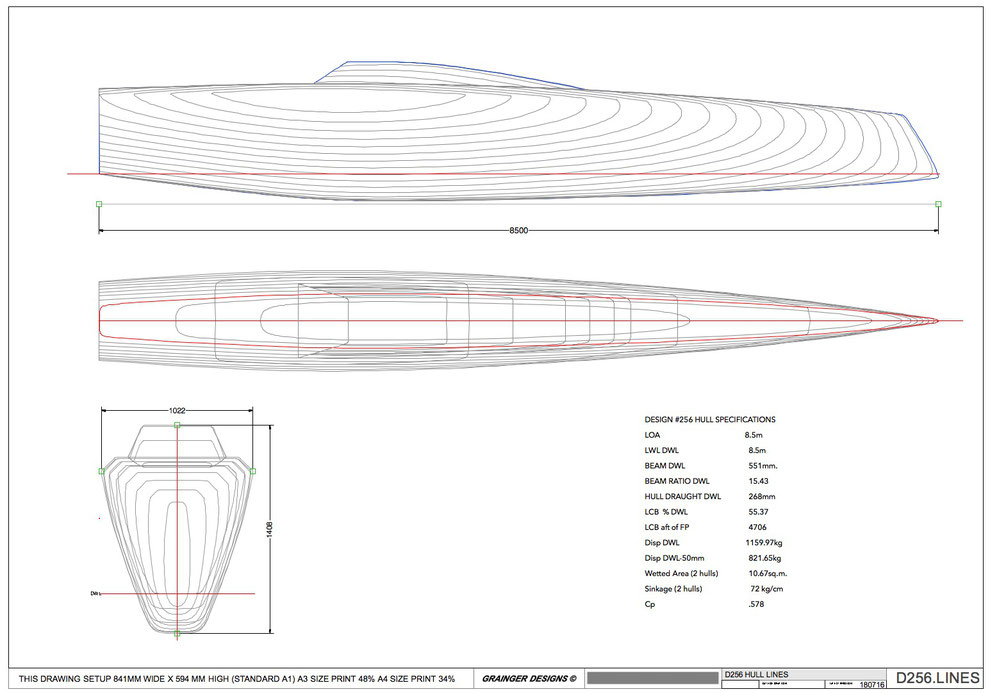
The hull lines of the new 8.5m Sports Cat Design 256
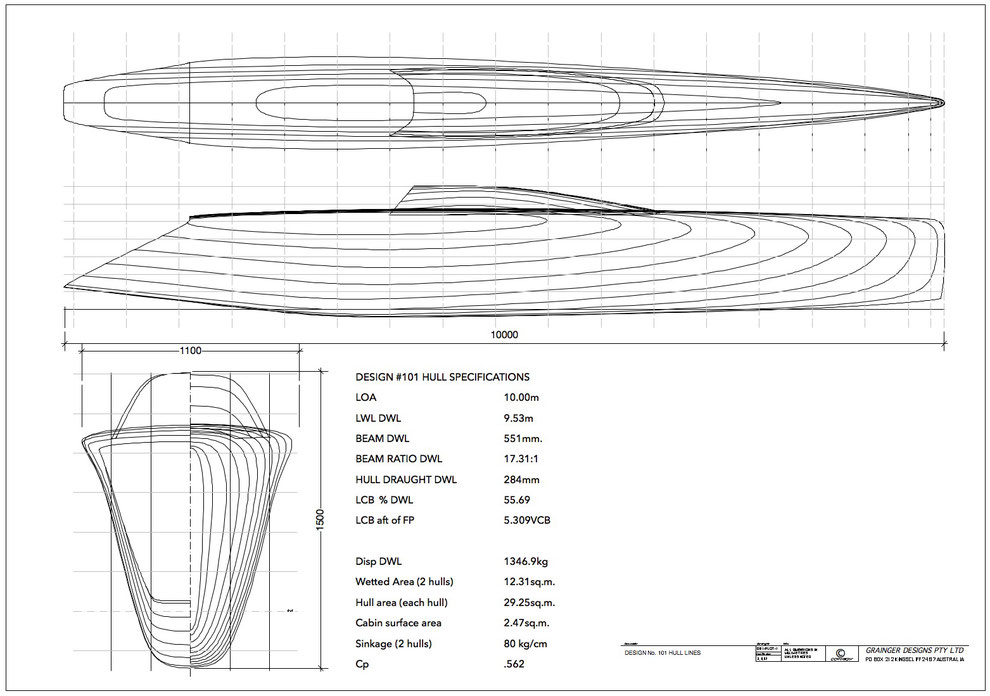
Mad Max , Previously Carbon Copy . She was designed in 1997 but she's the current (2016) title holder of the Australian Multihull Chamionships (2 successive years) and the fastest inshore racing boat in Australian waters.
Join the Newsletter

- Scroll to top

What Is A Catamaran Sailboat? (And What It Looks Like)

Last Updated by
Daniel Wade
August 30, 2022
Catamarans are increasingly popular for sailing and commercial use, but what sets them apart from monohulls and other multihulls?
A catamaran is a twin-hull boat with two equally-sized hulls placed side by side. They’re powered by engines, sails, or both—and they’re known for efficiency and speed. Catamarans are the most common kind of multihull boat.
In this article, we’ll go over the characteristics of catamarans and how to differentiate them from other types of boats. Additionally, we’ll cover the advantages and disadvantages of catamarans and compare them to trimarans and monohulls. We’ll also go over the most common types of catamarans and their uses.
We sourced the information in this article from marine design guides, boat identification resources, and the online boating community.
Table of contents
How to Spot a Catamaran
Spotting a catamaran is easy. Simply look at the hulls and count them. Catamarans have two hulls side by side and a relatively large gap between them where you can see light on the other end. Catamarans are distinct from trimarans, which have an additional hull between the two outer hulls.
How do Catamarans Work?
The principle behind the catamaran is simple. You can think of catamarans like cars and monohulls like motorcycles. Catamarans distribute their weight between hulls on either side, whereas monohulls utilize only one hull.
Evidently, cars are much more difficult to tip over and can hold much more weight. Additionally, cars are wider, as they have much more contact with the road. Catamarans work in a similar way, as they have a wide stance and contact with the surface on both sides.
Obviously, that isn’t the most precise comparison. But the basic principle is the same, and catamarans have a few notable benefits over monohulls.
Catamaran Vs Monohull
Catamarans are easy to distinguish from monohulls. A monohull is just a regular old boat with a single hull. The vast majority of boats and ships are monohulls. Catamarans have two hulls, which are usually sleek and narrow.
Here are some comparisons of catamarans and monohulls, along with the advantages twin-hull designs have over most single hull types.
Benefits of Catamarans
Catamarans have numerous benefits. The first is speed. Catamarans produce less drag than monohulls and thus can achieve excessive speeds both under sail and power. They don’t need to plane like monohulls to achieve these high speeds, and they use less fuel.
Catamarans are also much more stable than monohulls. They have a wide stance and shallow draft, and many waves and swells can travel between the hulls instead of below them. This effectively reduces an entire axis of movement and prevents catamarans from rolling excessively.
Drawbacks of Catamarans
Catamarans aren’t advantageous in every way, or else we wouldn’t bother building monohulls. The disadvantages of catamarans limit their use to niche commercial applications and high-end yachts. But what are the drawbacks of a twin-hull design?
Sailing catamarans don’t follow many of the traditional boat handling rules and characteristics that sailors pass down for generations. Some, such as hull speed limitations, are good to do away with—while others, such as responsiveness, are not.
Catamarans aren’t as quick to the helm or responsive as monohulls. There are some exceptions to this rule, but for the most part, you’ll get a lot more feedback from a single-hull vessel. Additionally, the large section of deck between the hulls of a catamaran is prone to pounding in rough seas, which is loud and uncomfortable.
Catamarans can sometimes be twice the width of an equivalent monohull sailboat, which can increase mooring fees and limit docking options.
The final major drawback of catamarans is a consequence of their stability. Traditional full-keel monohull sailboats have a very low center of gravity, which makes them roll in heavy seas but ensures a recovery.
Catamarans have a higher center of gravity, and they can’t right themselves after a knockdown. And though catamarans are less likely to roll, a severe list on a multihull is a much more serious concern than on a ballasted monohull.
Catamaran Vs Trimaran
Catamarans and trimarans are often lumped together, but they have very different design and performance specifications. Trimarans have three hulls, whereas catamarans have two.
Trimarans look a lot like catamarans from the side, but a quick glance at the bow or stern can set them apart. Trimarans are faster than catamarans, as they distribute their weight across three hulls instead of two. This helps them stay centered and reduces interference from pitching and rolling.
Catamarans are fast, but they lose out to trimarans when going head to head. However, catamarans are much less expensive to build and maintain and often have roomier cabins due to their larger hulls.
Types of Catamarans
There are numerous types of catamarans, and their uses vary widely. The catamaran is one of the oldest and most useful hull types, and some variants have been used for thousands of years. Here are the most common kinds of catamaran boats and their uses.
Sailing Catamaran
Sailing catamarans are probably what you think of when you hear the name. Sailing catamarans are sailboats with two identical hulls connected by a center deck. The largest sailing catamarans are spacious and stable vessels that are capable of serious offshore sailing.
Sailing catamarans have a number of notable advantages over monohulls. Monohulls, which are traditional sailboats with a single hull, are limited by a simple concept called hull speed. As the bow and stern wave of a monohull intersect, they cause drag which limits the top speed of the boat.
Catamarans are not bound by hull speed limitations, as they have two hulls. Catamarans can go twice or even three times as fast as similar monohulls and achieve excellent travel times.
Catamarans are also more stable than monohulls, as their wide stance and shallow draft reduce the effect of rough water. They don’t heel, as the force of the wind is counteracted by the double hulls. Additionally, modern sailing catamarans can ‘wave pierce’ by cutting through swells instead of riding over them.
Sailing catamarans come in many shapes and sizes. Small sailing catamarans, such as those used in races and regattas, are known for their speed and relative stability compared to light racing monohulls. Sometimes, they feature a smaller second hull for stability—these are called outriggers.
Sailing catamarans have spacious interiors thanks to the large cockpit between the hulls. This cockpit usually contains cooking and eating spaces, a place to sit, and a hallway between the hulls. The hulls usually contain living quarters and often mirror each other.
Power Catamarans
Power catamarans have an even greater variety than sailing catamarans. These vessels are used for everything from party platforms to ferries and patrol boats.
Power catamarans are a recent development, as engineers and marine architects now realize they have numerous hydrodynamic advantages over other hull types.
Catamarans are much more efficient than other hull types, as they have less drag relative to their size. Additionally, you can build a much larger catamaran with less material. This makes them popular for car and rail ferries, as builders can construct a very wide vessel with two small hulls rather than a narrower vessel with a large single hull.
Military and Commercial Catamarans
Even the military has found a use for the catamaran hull shape. The Spearhead class EPF is an expeditionary fast transport vessel designed for carrying capacity and speed. It has two sharp hulls and a huge cargo capacity.
The Spearhead class EPF is 337 feet long, which is about the same length as a WW2 escort destroyer. Yet despite having a similar length and displacement, these catamarans can travel more than twice as fast—43 knots, or nearly 50 miles per hour. Their great speed is a direct consequence of their catamaran hull type.
Power catamarans are also used as patrol and utility boats on a much smaller scale, with either outboard or inboard motors. The State of Texas uses catamarans to patrol shallow rivers and lakes. Texas Game Wardens utilize state-of-the-art aluminum catamaran patrol boats, which are fast enough to outrun most fishing boats.
There’s another form of power catamaran that you may not have considered. Pontoon boats are technically catamarans, and they’re enormously popular on lakes and rivers throughout the country. Pontoon boats aren’t known for speed, but they’re a great platform for a fun and comfortable outing.
Catamaran Houseboats
The final common type of power catamaran is the two-hulled houseboat. Houseboats don’t always use the catamaran hull type, but it’s common enough that most major manufacturers offer it as an option.
Catamaran houseboats have a few notable advantages over monohull designs. For one, they’re easier to build—especially when pontoons are chosen. Additionally, they’re better suited for navigating shallow water. These vessels can support more weight across their two hulls, offer increased stability, and they’re also efficient.
Why Aren’t Catamarans More Common?
With all the advantages listed in this article to consider, it may seem strange that the use of catamarans is still somewhat limited. At the end of the day, it comes down to economics—as monohull boats and ships are simply cheaper to build.
Additionally, catamarans have some distinct limitations. Monohulls have lots of storage space in their hulls and can carry thousands of tons of cargo safely in all weather conditions. Catamarans lack this space and low center of gravity, so they’re not ideal for transporting cargo past a certain point.
Additionally, monohulls work, and many people are reluctant to experiment with new designs when old designs work just fine. This rule applies to both large and small boats.
A large monohull sailboat can be constructed at low cost from stock plans and reliably sail almost anywhere. Very little complex structural engineering is involved, and looser tolerances reduce cost and maintenance requirements.
Related Articles
I've personally had thousands of questions about sailing and sailboats over the years. As I learn and experience sailing, and the community, I share the answers that work and make sense to me, here on Life of Sailing.
by this author
Learn About Sailboats
Most Recent

What Does "Sailing By The Lee" Mean?
October 3, 2023

The Best Sailing Schools And Programs: Reviews & Ratings
September 26, 2023
Important Legal Info
Lifeofsailing.com is a participant in the Amazon Services LLC Associates Program, an affiliate advertising program designed to provide a means for sites to earn advertising fees by advertising and linking to Amazon. This site also participates in other affiliate programs and is compensated for referring traffic and business to these companies.
Similar Posts

Affordable Sailboats You Can Build at Home
September 13, 2023

Best Small Sailboat Ornaments
September 12, 2023

Discover the Magic of Hydrofoil Sailboats
December 11, 2023
Popular Posts

Best Liveaboard Catamaran Sailboats
December 28, 2023

Can a Novice Sail Around the World?
Elizabeth O'Malley
June 15, 2022

4 Best Electric Outboard Motors

How Long Did It Take The Vikings To Sail To England?

10 Best Sailboat Brands (And Why)
December 20, 2023

7 Best Places To Liveaboard A Sailboat
Get the best sailing content.
Top Rated Posts
Lifeofsailing.com is a participant in the Amazon Services LLC Associates Program, an affiliate advertising program designed to provide a means for sites to earn advertising fees by advertising and linking to Amazon. This site also participates in other affiliate programs and is compensated for referring traffic and business to these companies. (866) 342-SAIL
© 2024 Life of Sailing Email: [email protected] Address: 11816 Inwood Rd #3024 Dallas, TX 75244 Disclaimer Privacy Policy

Catamaran Parts Explained: Interactive Guide (For Beginners)
As an Amazon Associate, we earn from qualifying purchases. We may also earn commissions if you purchase products from other retailers after clicking on a link from our site.
Learning a new skill can sometimes be time-consuming, and learning to sail also means learning a new language with tons and tons of new words that, in the beginning, makes no sense at all.
Some of the words you will read about in this article stem from the early days of sailing. Some are only a decade old; in this article, I have tried to compile all the basic terminology that I believe a beginner needs if he or she wants to understand sailing and catamarans.
Feel free to use this article as a resource and come back to it when you want to look something up or just to learn more!
Table of Contents
Main sections on a catamaran
- Hulls; are what separates a cat from other sailboats, a catamaran has two hulls, a trimaran three, and a regular sailboat, aka monohull, has one. The hull is the part of the sailboat which makes it float and to where all other things are attached. The hulls are usually divided into sections, such as usable and non-usable area. An example of a usable area is the engine room.
- Cockpit ; is from where the boat is maneuvered; it is to here that all halyards, sheets, etc. go. The cockpit contains navigation and steering equipment and is from where the sails, rudder, and engine are controlled.
- Deck; is the top part(roof) of a catamaran covering the hulls and bridge deck. The deck is made hard enough to walk on. To the deck, attaches lifelines and other equipment.
- Sugarscoops ; are the aftmost part that gets their name from their scoop-shaped appearance; this is where the deck/cockpit meets that water and usually encompasses a stair or ladder for easy access depending on the size of the boat.
- Cabin; is basically any area on the inside of the boat that is protected from the weather and is made to offer the crew space to rest, eat, and hangout. Inside the cabin, you will find berths (beds), a galley (kitchen), and sometimes specialized areas for repairs or storage.
- Bridgedeck; connects the two hulls; the inside is the cabin, the top part is the deck, and the entire unit is called the bridge deck. Bridge deck clearance, the bridge deck’s height above the water, is an important factor on a catamaran since a too small clearance will create excess noise and vibrations and fatigue not only the crew but also the boat.
Main areas on a catamaran
Bow (front).
Nothing complicated here; the bow is just a nautical term for the foremost part of your boat. This is where the waves and the sea first meet the hull and depending on the type of boat, the bow(s) can be shaped differently.
Center (Middle)
The part between the bow and the stern is rarely called the center part( middle) of a boat; more common is to speak about the specific area situated within the middle part of the vessel, such as the cabin or the mast.
- Cockpit; as mentioned above, here you will (usually) find everything that you need to maneuver and navigate the boat, such as a compass, GPS, sheets, steering wheel, and throttles for the engines. Some boats may not be set up this way and require you to move around the boat to access certain controls.
Cabin (inside of the boat)
The boat’s interior is where you will find everything that is made for the crew’s enjoyment; it is a place to eat, sleep, rest up, and hide away from nasty weather.
- Berths; is a bed; sailors need to sleep too!
- Galley ; is another name for kitchen, usually set up in a very primitive way with a gas stove on a stabilized platform to ensure your food won’t get tossed around.
- Navstation; or navigation station, is a place, usually with a table, chair, and equipment for planning and logging a journey.
Stern (Back)
Stern is the name for the rearmost part of the boat; there is no clear definition as to where the stern stops and other parts begin, so it is something that the crew will have to figure out on their own through good communication.
Communicating directions on a sailboat
Not only will you have to know the different names of different areas on the boat, but it will also be essential to communicate clearly in what direction something is happening, for example, in a situation where you, the captain, want the crew to observe in a specific direction or pick up a piece of gear somewhere on the boat.
Communication on a sailboat is vital when you want to sail safely and efficiently; here, I have listed the words or phrases used to communicate a direction.
- Forward; easy as it sounds, it is the same direction as where the bows are pointing. When giving directions towards or beyond the bow, you will use the word “forward” for example; the fender is located forward of the mast.
- Aft ; is the behind the boat. When you are giving directions towards the stern, you will use the word “aft”; for example, the cockpit is located aft of the mast.
- Port ; this will be your left side. Fun fact, in the good old days, you would always dock with the port on your left side; hence port is the left side. If you ever forget which one is which, “port” has 4 letters and so has the word”left”!
- Starboard ; is your right side!
Types of sails
Sails come in very different shapes and sizes and are a science in itself; in this article, I will focus on the mainsail and three common types of staysail.
- Mainsail; is, per definition, the sail attached to the mast; its sideways movements are controlled by the boom. When the mainsail is triangular in shape, as on most modern sailboats, it is called a Bermuda rig. Most mainsail uses something called battens.
- Staysail; mainly comes in two versions, a staysail that does not overlap the mainsail is called a jib. A staysail that is larger and thus overlaps the mainsail is called a genoa.
- Spinnaker ; is a big balloon-like sail that replaces the jib when sailing downwind.
Parts of a sail
- Luff; the front part of the sail, is connected to the mast through a rail system which makes it possible to hoist or reef.
- Leech; the back part of the sail.
- Foot; the bottom part that reaches from the clew to the tack.
- Clew; back bottom corner.
- Tack; is the front bottom corner (remember “tacking”?).
- Head; is the top triangle of the sail and this is where the mainsail halyard attaches.
- Battens; are pieces of flexible material sewn into the mainsail to increase its aerodynamic shape. Battens can be full length or partial length.
Standing rigging
Everything that keeps the sails and mast upright are parts of the standing rigging; it is comprised of wires, cables, and lightweight metal structures.
- Forestay; usually a metal wire running from the top of the mast to the bow, is sometimes combined with an inner forestay that connects to the mast at a lower point. If the forestay attaches to the top of the mast, the setup is called a masthead rig; if it attaches lower, it is called a fractional rig.
- Backstay ; same as the forestay but attaches to the stern; most catamarans do not employ a backstay system but instead moves the side stays aft.
- Shroud ; much like the forestay but stabilizes the mast sideways and runs from the top to the port or starboard side. Spreaders are used to change the angle of the wire against the mast and better support the mast.
- Sidestay ; connects to the mast below the shrouds and is not pushed outwards with spreaders. On a catamaran, these attach aft of the mast to eliminate the need for a backstay; this makes it possible for a fully battened mainsail with a large roach.
- Jumpers; are used on a fractional rig with diamond shrouds to add structural integrity to the mast without adding excess weight.
- Bowsprit; is a pole amidship at the bow that allows for separation of the tacks (foremost, lower part of the sail) for increasing sail efficiency when using two headsails.
Other stabilizing parts
- Spreaders; act to lessen the angle between the shrouds and the mast; a wider angle will result in forces acting sideways (stabilizing) instead of up and down (bending). This increases stability and decreases the risk of unwanted bending of the mast.
Running rigging
The running rigging on a catamaran is any piece of equipment used to control the shape of the sails, including what is needed to raise them.
- Sheet; are the ropes (or wire, cables, etc.) that connect to the clew of a sail; on a catamaran, it connects to the staysail (genoa or jib, depending on the shape).
- Mainsheet ; is the rope that makes it possible to change the mainsail’s angle; the mainsail can only move in a port to starboard direction(right and left) and not up and down.
- Staysail sheet ; is called after whatever type of sail it is connected to, i.e., jib sheet or genoa sheet. Worth notice is that since the staysail operates on both sides of the catamaran (depending on if your tacking or gybing), it is connected with two ropes, one for the port side and one for the starboard side.
- Halyards ; are the ropes that connect to the top of a sail and make hoisting (or raising) possible. Halyards have different names depending on what sail they are raising, such as Mainsail halyard or jib halyard. Not to be confused with sheets that act upon the sail once they are already hoisted. If the staysail is using a roller furling, then “hosting” is done differently.
- Furling line; is used together with a roller furling and makes it possible to spool up the sail on the forestay instead of raising and lowering. This makes for a faster and easier way to reduce sail area.
- Reefing lines; reefing is when you lower parts of your sail to reduce the sail area and reduce the boat’s power and speed; reefing lines are put through holes in the mainsail and attach to the boom.
- Boom vang; is connected between the boom and deck; it is used to change the mainsail’s shape by pulling downward on the boom. (not very common on Catamarans)
In this category, we will look at the hulls and some of the vital parts that attach to them under the waterline.
- Hulls; differ in their shapes depending on the boat’s purpose, a racing cat would have narrower hulls to reduce drag, and a cruising cat wider hulls to encompass more storage.
- Rudder; is what changes the direction of the boat. When water passes around the rudders(two on a catamaran), it creates a “pushing force” that makes the boat turn. The rudder is connected to a steering wheel or a tiller at the cockpit through chains and linkage.
- Centerboard and daggerboards ; are sorts of keels that can be raised or lowered to attain certain sailing characteristics. When the keel is up, drag is lower, and so is the draft (how deep the boat sticks in the water). A small draft makes it possible to travel in very shallow waters. The difference between a daggerboard and a centerboard is that a centerboard swivels into place, and a daggerboard is pulled straight up.
- Mini-keel; is just what it sounds like; it is a keel but very small (a few inches deep) and has no ballast.
- Crossbeam ; is a multihull-only feature and keeps the two hulls from moving in relation to each other. If the crossbeam is damaged or nonexistent, the bridge deck is the only thing that keeps the hulls in place. This will increase wear and sooner or later lead to cracks, or even worse, separation of hull and bridge deck.
Most catamarans have two engines, one on each hull aft the stern; usually, they are internal with only the propeller in the water. The other option, which is cheaper and most often found on smaller boats, is to have one outboard engine placed amidship (middle).
- Inboard ; engines are situated in a compartment inside the boat at the stern. On an inboard engine, the propeller and the shaft are the only parts outside the hull. Sometimes the prop shaft (propeller shaft) is replaced by a sail drive.
- Outboard ; is a standalone engine usually mounted on the bridge deck amidship(if only one is used) or mounted at the sterns when used in pairs. They are linked together with pushing rods and wires so it can be manipulated from the cockpit.
- Saildrive ; is a type of gearbox that is quieter and vibrates less than a regular propeller and shaft setup.
- Propeller and shaft; are the most common and cheapest way to propel your boat. It is basically just a watertight axel that sticks out of the hull, and at the end of it, you’ll find the propeller.
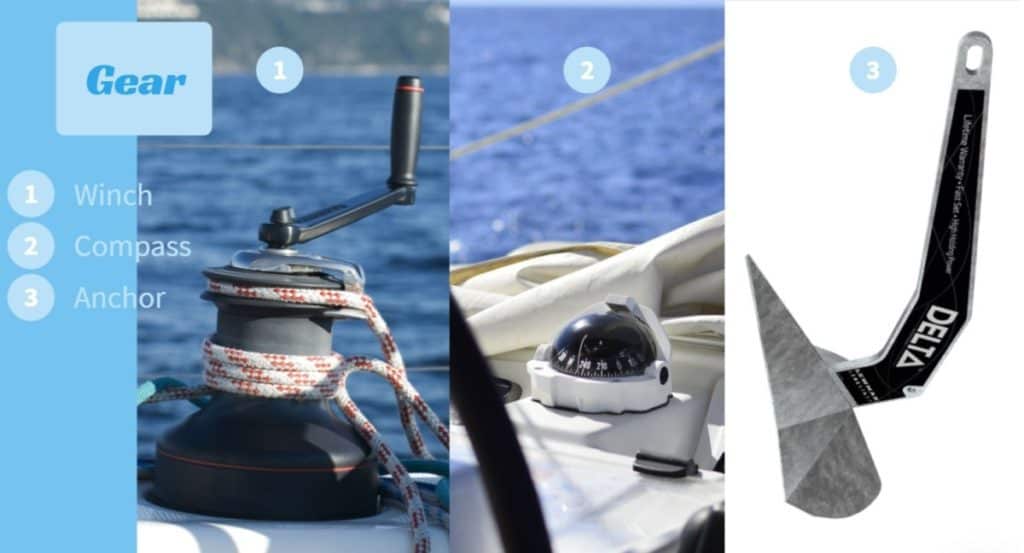
There are so many pieces of gear aboard a catamaran that an all-encompassing article would probably fill up the entire internet. Below I have listed the most common equipment that you will most likely encounter on any sailboat.
- Winches; makes handling lines and ropes much easier. Instead of pulling them with your bare hands, you loop them around your winch and use the handle to crank. Winches come in mechanical style or electrical style.
- Anchors ; is basically just a big hook made to stick to the bottom of the sea. Anchors have different shapes and weights depending not only on the seabed but also on the boat’s weight and size.
- Navigation ; compass, GPS, and maps are all vital pieces of equipment making your trip safe.
- Cleats ; is any equipment that is made to fasten a rope. Cleats come in different configurations; jam, cam, rope clutch, or the most common horn cleat.
- Block ; is a device that can be used in pairs as a pulley (to reduce the force needed to lift something) or on its own to reduce the friction of a rope when the rope can not be drawn in a straight line.
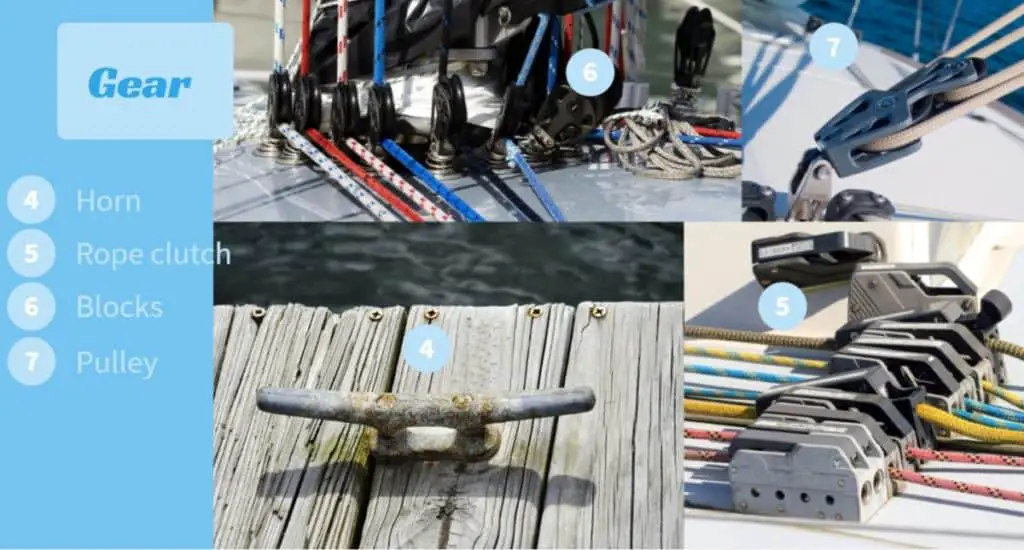
Owner of CatamaranFreedom.com. A minimalist that has lived in a caravan in Sweden, 35ft Monohull in the Bahamas, and right now in his self-built Van. He just started the next adventure, to circumnavigate the world on a Catamaran!

Leave a Reply Cancel reply
Your email address will not be published. Required fields are marked *
Save my name and email in this browser for the next time I comment.
Recent Posts
Must-Have Boat Gear for Catamaran Sailors!
Sailing is probably the most gear-intensive activity I've ever done; there are so many decisions to be made about what gear to buy now, for tomorrow, and what to definitely never buy. The gear on...
6 Best Trailerable Trimarans For Bluewater and Coastal Sailing
Having a boat costs a lot of money, even when you are not using it, marina fees, etc. And once it is in the water most sailors never go very far from their "home marina" and sailing will be somewhat...
Shape & Resistance
A boat's hull shape and the distribution of volume are key factors in determining how it will behave in varying wind and load conditions. The underwater characteristics of a vessel are responsible for allowing a multihull and its cargo to travel through the water. The faster and more effortlessly the twin hulls can displace the surrounding fluid, the less resistance and more efficient a catamaran will be.
Typically modern catamaran designs have sharp bows to drive the vessel through the seas with as little wave making as possible. High freeboard assures a dry ride. Ample buoyancy helps keep the stems out of the water and spray to a minimum. Elliptical sections make up the first third of the hull, providing an easy entry in the water and some means to resist leeway. Towards the middle of the boat, gradually flattening out towards the stern, the sections become semicircular to help distribute buoyancy. These portions help carry payload and facilitate the hull lifting at speed. Basically, the majority of all cruising catamarans share these same underwater features.
Decades ago very seakindly, double-ended hull shapes were the norm as found in the thousands of Wharram catamarans. They were easy to construct, relatively slippery, and provided ample freeboard. Unfortunately they could not carry a lot of cruising gear, had cramped accommodations and were not the best windward performers. Their sharp V-sectioned hulls and rudders were their only means of resisting leeway as they had no leeway preventing devices. Similarly, the narrow asymmetrical type hull, such as found in the Hobie 16 beach catamaran, is hardly used in today's cruising multihull. The idea was to keep the underwater appendage to a minimum and eliminate any keels or daggerboards.
In contrast, the modern catamaran benefits from tank testing and computer-aided design. Composite molding technology allows for infinite shapes and each designer or manufacturer can now realize his idea of the perfect hull shape. Today's mini keels and daggerboards keep the cat hard on the wind and rival the weatherliness of monohull racers.
Drag on the hulls is the main deterrent to speed and has many components. We have to distinguish between water and air drag. Water-induced resistance can be further broken down into drag caused by wetted surface and wave making. Wetted surface, which is the frictional resistance the hulls experience when they are passing through the water, is the main cause of resistance at low speed. Wave making becomes more important as boat speed exceeds hull speed , or 1.34 x square root of the waterline length. Wave making resistance is not as easy to analyze and is more complex than drag caused by wetted surface; it is primarily a function of weight and, secondarily, of hull shape.

Pitch is another form of drag which can slow the boat down. This unwanted phenomenon is directly related to the buoyancy of the extremities and weight distribution. Wave-making resistance caused by the boat's constant plunging will slow a multihull, especially since it has less momentum to drive it through waves as compared to a single-hulled vessel. In addition the airflow over the sails will be disturbed by a constant change of attitude, further hindering efficient progress. Pitching can also be caused by placing items that are too heavy into the extreme ends of the multihull. In addition, various design- and construction-related issues can cause this problem, such as bridge decks extending too far forward of the mast and a high, heavy rig. Solid decking instead of trampoline nets, and/or large protrusions, which strangely some manufacturers claim break up waves, can also cause a hobby-horsing effect. Not only can this result in more wave-making drag than desired, but can seriously tire the crew. Any structure ahead of the mast can cause major slamming when having to face steep seas. Although many cruising catamarans, such as the Prouts, have been built with large bridgedeck structures extending forward to the bows, it is my opinion that an open trampoline, which poses no resistance to wind and seas, is imperative on a good cruising cat.
above High freeboard and angled-out hulls are trademark features of this capable Catana 521. Much thinking has gone into the hull shape of this catamaran, yet the pronounced step running along the inside of the vessel might create some wave slap in some conditions, a typical example of a compromise between space and performance.
Resistance & Performance
Resistance vs. Speed of four different vessel configurations
A. Traditional, heavy displacement monohull cruiser
B. ULD (Ultra Light Displacement) monohull
C. Typical performance catamaran cruiser
D. Racing multihull, with almost no wave making resistance below A popular French catamaran, as photographed out of the water at the Paris Boat Show . Note that there are barely several inches of clearance between the bridgedeck and waterline. The pronounced forward knuckle of the nacelle is claimed to break up waves. In my mind however, there is very little that can resist the continued impact of seas, and any conflict between the wingdeck and waves should be avoided.
Continue reading here: Catamaran Sailboat Wide Bodied Hulls
Was this article helpful?
Recommended Programs

Myboatplans 518 Boat Plans

Boat Alert Hull ID History Search

3D Boat Design Software Package
Related Posts
- Catamaran Design Guide - Catamarans Guide
- Design Dynamics - Catamarans Guide
- Hull Hydrodynamics and Design
- Catamaran vs Monohull - Catamarans Guide
Readers' Questions
What is a characteristic of a catamaran hull?
A characteristic of a catamaran hull is that it has two parallel hulls, which provide greater stability than a monohull vessel and help reduce roll, pitch and yaw. Catamarans also generally require less power to achieve a given speed than a monohull and provide improved handling characteristics in open water.
What may cause hull on catamaran to bend?
Hull flexing on catamarans may be caused by several factors, such as high winds, strong waves, heavy loads, and improper loading. Poorly designed or constructed hulls can also be more vulnerable to flexing.
How to construct catermaran hull show pictures?
Unfortunately, it is not possible to construct a catamaran hull with pictures alone. A catamaran hull is a complex structure that requires precise measurements and calculations in order to ensure that it is structurally sound and performs optimally when in the water. If you would like to learn more about constructing a catamaran hull, you should refer to resources such as books, websites, and experienced boat builders who can provide you with detailed instructions.
How far should a catamaran bridge be of the water?
The height of a catamaran bridge will depend on the size and type of the catamaran. Generally, a bridge should be slightly above the water line, typically between 6 and 12 inches.
How to get catamaran hull resistance?
Catamaran hull resistance is determined by a number of factors, such as the shape of the hull, length and beam dimensions, wetted surface area, type of appendages, and underwater profile. To determine the resistance, the hull needs to be tested in a towing tank or in the open water. The resistance coefficients obtained by testing can then be used to calculate the total resistance of the catamaran hull.
Parts of Catamaran: A Comprehensive Guide to Understanding the Components
by Emma Sullivan | Aug 2, 2023 | Sailboat Racing

Short answer: The key parts of a catamaran include the hulls, bridgedeck, mast(s), rigging, sails, rudders, and daggerboards. These components work together to provide stability, propulsion, and control for this type of multi-hulled watercraft.
Exploring the Essential Parts of a Catamaran: A Comprehensive Guide
From cruising the open seas to enjoying lazy afternoons by the shore, catamarans have become a popular choice for water enthusiasts. With their unique design and exceptional stability, these vessels offer an unmatched sailing experience . But have you ever wondered what makes up a catamaran and how each part contributes to its overall functionality? In this comprehensive guide, we will take you through the essential parts of a catamaran, uncovering their purpose and shedding light on why they are instrumental in making these boats such fantastic options for adventure seekers.
1. Hulls: The hulls are the twin structures that form the main body of a catamaran. These structures play a pivotal role in providing stability and buoyancy while at sea. Catamarans boast wider hulls compared to traditional monohull sailboats, resulting in increased surface area and enhanced stability. The design allows for smoother sailing even in rough waters, as each hull slices through waves independently.
2. Keels: Unlike monohull sailboats that rely solely on a single keel positioned beneath the waterline for both lift and resistance against sideways drift (known as leeway), catamarans often feature two separate skegs or keels attached to each hull. These auxiliary structures enhance directional control and offer excellent stability while reducing drag.
3. Deck: The deck is where all the action takes place! It serves as the primary horizontal surface on which passengers can relax, sunbathe or engage in various activities while aboard the vessel. Catamaran decks usually come with ample space due to their wider design compared to monohull sailboats .
4. Trampoline: One of the standout features of a catamaran is its trampoline – a mesh-like netting stretched between the two hulls just above sea level. While it may seem like an unconventional addition, trampolines provide multiple benefits including giving passengers an exhilarating sensation as they sit or lay above the water. This ample recreational area additionally offers an unobstructed view of the sea, making it an ideal spot for stargazing or simply enjoying the soothing sound of the waves.
5. Cockpit: The catamaran’s cockpit is strategically positioned closer to the waterline, ensuring a thrilling and immersive sailing experience. It acts as the primary control center where the helm is located, allowing sailors to expertly navigate their vessel through various seascapes. Additionally, some catamarans offer spacious cockpits that provide sufficient seating capacity for socializing with fellow passengers or hosting intimate gatherings while at anchor.
6. Rigging: The rigging refers to all lines, cables, and hardware necessary for controlling and adjusting the sails . Catamarans typically employ a simple yet effective rigging system that ensures easy maneuverability and efficient sailing performance. By skillfully managing these components, sailors can harness wind power optimally and maintain smooth cruising speeds in any weather conditions.
7. Sails: Sails are central to a catamaran’s propulsion system, enabling it to move gracefully across bodies of water without relying on fuel-based engines alone. Modern catamarans often embrace a sail plan consisting of multiple sails designed to maximize efficiency and adapt seamlessly to varying wind strengths and directions. With innovative designs such as fully battened mainsails and lightweight genoas, these boats have become incredibly agile even when faced with challenging wind patterns.
8. Engines: While a catamaran’s sails provide a significant portion of its power source, auxiliary engines are still crucial for many aspects of sailing life – be it docking in tight spaces or maneuvering during low-wind situations. These engines are usually mounted within each hull beneath deck level as part of an integrated propulsion system comprising shafts, propellers, and operational controls.
9. Navigation Instruments: In today’s era of advanced technological aids, catamarans make use of a range of navigation instruments to enhance safety and efficiency. From GPS systems providing precise positional information to depth sounders measuring water depth, these sophisticated tools are essential for ensuring smooth journeys and avoiding potential hazards.
So there you have it – a detailed glimpse into the essential parts of a catamaran. Wherever your sailing adventures take you, now you can fully appreciate how each component contributes to the incredible performance and unrivaled experience offered by these magnificent vessels. So hop aboard a catamaran and embark on your next nautical journey with confidence!
How to Identify and Understand the Various Components of a Catamaran
Catamarans are fascinating vessels known for their unique design and exceptional performance on the water. Whether you are a seasoned sailor or just interested in learning more about these incredible boats, understanding their various components is essential . In this blog post, we will take a detailed, professional, witty, and clever dive into the world of catamarans and shed light on how to identify and understand their different parts .
1. Hulls: At the core of any catamaran are its hulls – the main supportive structures that keep the boat afloat. Unlike traditional single-hulled vessels, catamarans have two parallel hulls connected by a deck. These hulls play a vital role in providing stability and minimizing drag while sailing. Think of them as the sturdy legs that help the catamaran gracefully glide through the water .
2. Deck: The deck serves both as a platform for enjoying your time onboard and as an important structural element that connects various parts of the catamaran. It consists of multiple areas such as the helm station (where you control the boat), seating areas, dining spaces, trampoline nets for lounging, and storage compartments. Sunbathing or hosting friends for a sunset gathering? The deck has got you covered!
3. Rigging: If you’ve ever looked up at a sailboat’s mast with admiration, then you’ll love discovering how rigging contributes to a catamaran’s overall performance and elegance. The rigging includes all the supporting wires and ropes that hold up the mast(s) on your catamaran and control its position relative to wind direction (known as “trimming”). Understanding how to properly trim your sails can greatly enhance your sailing experience – from capturing optimal wind power to achieving picture-worthy maneuvers.
4. Sails: What could be more mesmerizing than watching billowing sails against an azure sky? Catamarans utilize various types of sails based on their purpose – mainsails, jibs, genoas, spinnakers – each designed to maximize performance under specific wind conditions. Learning about the different sails and their characteristics will help you navigate efficiently and make the most of your sailing adventures. Plus, understanding the art of sail trim is sure to impress your fellow sailors!
5. Rudders: Just as a captain relies on his or her compass for navigation, catamarans depend on rudders to steer through the water with precision. Mounted at the stern (rear) of each hull, these ingenious components allow you to control your course by diverting the flow of water passing beneath them. Rudders are essential for maintaining stability and maneuverability when tacking, jibing, or navigating challenging waters.
6. Engines: Catamarans aren’t solely reliant on wind power; they often incorporate engines as auxiliary means of propulsion. These mechanical marvels provide added security and flexibility during low-wind situations or when maneuvering in confined spaces like marinas or crowded anchorages. Understanding how to handle your catamaran’s engines confidently will ensure smooth sailing even when Mother Nature plays hard-to-get.
By expanding your knowledge about these various catamaran components – hulls, deck, rigging, sails, rudders, and engines – you’ll unlock a whole new level of appreciation for these magnificent vessels and gain confidence in navigating them.
Lastly, remember that wit and cleverness go hand-in-hand with professionalism when exploring any topic. So have fun while unraveling the mysteries of catamaran anatomy! Perhaps envision yourself as an expert sailor who can distinguish port from starboard blindfolded or sharpen your comedic skills by jokingly referring to hulls as “feline foundation” (though cats might not appreciate sharing their name with boats!).
Happy sailing!
Step-by-Step Breakdown: Unraveling the Mysteries behind Catamaran Anatomy
Catamarans have become increasingly popular in recent years, mainly due to their unmatched stability and impressive speed capabilities. But have you ever wondered what lies beneath the sleek exterior of these remarkable vessels? In this blog post, we will delve into the intricate details of catamaran anatomy, providing you with a comprehensive understanding of how these boats are constructed and why they excel on the water.
1. The Hulls: The Foundation of Stability At the core of every catamaran lies its hulls – two parallel structures that run alongside each other. Unlike traditional monohull boats that feature a single hull, catamarans distribute their buoyancy across two hulls, offering superior stability even in rough waters. These hulls are typically made from fiberglass or aluminum and are designed to cut through waves effortlessly, minimizing resistance and maximizing speed.
2. Bridging the Gap: The Trampoline One striking feature present in many catamarans is the trampoline located between the two hulls. This sturdy mesh-like material serves various purposes. Firstly, it provides an additional platform for sunbathing or relaxing while underway. Secondly, it acts as a safety net by preventing crew members or passengers from falling into the ocean should any unexpected jolts occur during navigation .
3. Connecting Hulls: The Crossbeams In order to maintain structural integrity and connect both hulls securely, catamarans utilize crossbeams that stretch between them. These crossbeams play a vital role in sharing weight distribution evenly across both sides, ensuring stability and balance at all times.
4. Above Deck: Central Cockpit and Living Space Moving upwards onto the deck area, you’ll discover a central cockpit where most controls and steering mechanisms are located. This strategic placement allows for optimum visibility and easy maneuverability while sailing. Additionally, catamarans often feature large living spaces, including saloons and cabins that provide ample room for socializing, dining, and sleeping. Their spaciousness is a significant factor contributing to their growing popularity among cruising enthusiasts.
5. The Power of Sails: Rigging and Sail Plan Catamarans rely on sails for propulsion, utilizing a complex system of rigging to hoist and control them effectively. A unique feature of catamarans is the absence of a single mast; instead, they employ multiple masts strategically positioned between the hulls. This configuration optimizes sail area while reducing heeling (when a boat tips sideways due to windy conditions), resulting in smoother sailing experiences even during stronger winds.
6. Additional Features: Daggerboards or Foils To enhance performance further, some catamarans are equipped with daggerboards or foils – retractable appendages located beneath each hull. These boards reduce lateral slippage by providing lift, improving upwind capability and enhancing overall speed. As technology advances, advanced hydrofoil systems have also been introduced in certain catamaran models, allowing these boats to glide above the water ‘s surface entirely.
By unraveling the mysteries behind catamaran anatomy step-by-step, it becomes evident why these vessels are highly sought after by both leisure sailors and competitive racers alike. From their stable hull design to innovative features such as trampolines and foils – every element plays its part in creating an exceptional sailing experience that combines comfort, speed, and versatility. Perhaps now you can fully appreciate these engineering marvels whenever you set sight on one gliding gracefully through the waves!
Frequently Asked Questions about the Different Parts of a Catamaran Answered
Have you ever looked at a catamaran and wondered what all those different parts are called? Or maybe you’re thinking about buying or renting a catamaran and want to be familiar with its components . Well, look no further! We’ve compiled a list of frequently asked questions about the different parts of a catamaran and will provide detailed, professional, witty, and clever explanations just for you.
1. What is a Catamaran? A catamaran is a type of boat that consists of two parallel hulls connected by a deck. It offers increased stability compared to traditional monohull boats due to the wider beam. This unique design allows for smoother sailing experiences and more spacious interiors.
2. Hulls – What Are They? The hulls are the main structure of a catamaran, providing buoyancy and supporting the entire vessel. Typically made from fiberglass or aluminum, they have curved shapes that help reduce resistance in the water while providing stability. Think of them as the legs of the feline-inspired boat!
3. Trampoline – Isn’t That for Jumping? While it may sound similar to the equipment used for bouncing around at your local playground, in the world of catamarans, trampoline refers to an open area between the hulls where passengers can relax or even stretch their sea legs! Made from durable materials like nylon mesh or PVC canvas, trampolines provide excellent circulation and an unobstructed view below deck.
4. Rigging – Is it Related to Sailing Techniques? Indeed! Rigging refers to all the elements involved in controlling sails on a catamaran . This includes mast(s), boom(s), standing rigging (shrouds & stays), running rigging (halyards & sheets), winches, cleats – basically everything needed to manipulate wind power efficiently and safely navigate through various conditions.
5. The Mast – How Tall Should It Be? The mast, often made of aluminum or carbon fiber composite, is the tall vertical pole that holds up the sails. Its height depends on several factors, such as boat size, intended use, and the desired sail area. Think of it as the catamaran’s lighthouse – guiding you along your aquatic adventures with grace.
6. Boom – Not Just a Sound Effect! Nope, not just an imitation of an explosion! The boom is a horizontal spar attached to the bottom of the mast, helping support and control the lower edge (foot) of the mainsail. It swings back and forth with changes in wind direction – think of it as a catamaran’s wagging tail!
7. Daggerboards – Are They Catamaran Ninja Weapons? While they may sound dangerous and ninja-worthy, daggerboards are actually retractable foils that extend from each hull into the water. Their purpose? Providing lateral resistance against sideways motion caused by wind force while improving upwind performance by reducing leeway – no martial arts skills required!
8. Rudders – Steering Like a Pro Like most boats, catamarans have rudders for steering purposes. These underwater blades at the stern help control direction by redirecting water flow around them when turned. Whether you’re tacking or gybing through waves or researching rudder-related puns like this one—we’ve got you covered.
So there you have it – frequently asked questions about the different parts of a catamaran answered in detail! Now you can impress your fellow sailors with your newfound knowledge or confidently embark on your next seafaring adventure aboard one of these sleek double-hulled vessels ! Remember to keep exploring and enjoy every nautical mile!
The Key Elements That Make up a Catamaran: Everything You Need to Know
Title: The Key Elements That Make up a Catamaran: Everything You Need to Know
Introduction: Catamarans have long fascinated sailing enthusiasts with their unique design, efficient performance, and spacious interiors. Whether you are a seasoned sailor or a curious novice, understanding the key elements that make up a catamaran is essential. In this enlightening article, we will delve into the intricate details of these remarkable vessels, uncovering the secrets behind their success on the open seas .
1. Hull Design: Stability Meets Speed At the heart of every catamaran lies its dual-hull structure. Unlike traditional monohulls, catamarans feature two separate hulls connected by a spacious deck. This design offers enhanced stability and reduced heeling, making them less prone to capsizing compared to their single-hulled counterparts. The inherent buoyancy allows for faster speeds and smoother sailing experiences—enabling both exhilarating adventures and relaxed cruising.
2. Beam: Embracing Extra Space One of the most significant advantages of a catamaran is its beam—the width between its two hulls—which can be quite impressive. The ample beam creates an exceptionally generous living area that sets catamarans apart from other sailboats . More space means greater comfort for passengers and crew alike; accommodating larger groups, luxurious amenities, and even personalized additions such as Jacuzzis or sunbathing decks.
3. Stability & Balance: A Steady Journey In addition to their unique structural design, catamarans offer exceptional stability through weight distribution and physics principles. With twin hulls spread apart at a considerable distance, it becomes significantly easier to maintain balance during sailing motions—a significant advantage for those susceptible to seasickness or seeking effortless navigation under challenging conditions.
4. Sailor-Friendly Handling: Ease-of-Use at Sea Catamarans excel in terms of maneuverability due to several factors working harmoniously together. Their shallow drafts allow for exploration in shallower waters, and docking becomes a breeze with the ability to navigate narrower marinas. Furthermore, their twin engines operate independently, offering excellent control even in tight spots or challenging wind conditions—a maneuverability dream for sailors of all skill levels.
5. Sailing Performance: Effortless Speed When it comes to performance on the water, catamarans stand tall once again. The efficiency gained from their two hulls reduces drag and enables quicker acceleration, resulting in higher average speeds than traditional monohulls. Even when faced with light winds, their ample deck space allows for customized rigging options—such as efficient sails or high-tech foiling capabilities—that can unlock extraordinary speed potential.
6. Comfortable Living Spaces: An Unprecedented Haven Catamarans redefine on-board living by providing both ample space and superior comfort. The expansive interior saloon offers panoramic views of the surroundings while being versatile enough to cater to various activities—from hosting lively social gatherings to peacefully reading a book by the window. Additionally, private cabins are often located in each hull, creating secluded sanctuaries for relaxation and tranquility amidst enchanting seascapes.
Conclusion: As we conclude our exploration into the key elements that make up a catamaran, it becomes evident why these vessels have become revered in the sailing world . The revolutionary dual-hull design ensures stability and faster speeds while offering unparalleled comfort and spaciousness aboard. Whether you seek adventure or serenity on the seas, understanding these elements will help you appreciate catamarans’ remarkable qualities truly—an embodiment of innovation and maritime excellence brought together harmoniously by human ingenuity.
Mastering the Parts of a Catamaran: A Beginner’s Guide for Sailing Enthusiasts
Are you a sailing enthusiast who is fascinated by the sleek and efficient design of catamarans? If so, then you’ve come to the right place! In this comprehensive beginner’s guide, we will delve into the key components of a catamaran and unlock the secrets to mastering its various parts. So grab your sailor’s hat and get ready to embark on an exciting journey through the intricate world of catamaran sailing!
The first component that sets a catamaran apart from other sailboats is its dual-hulled structure. Unlike traditional monohull sailboats, which have only one hull, catamarans feature two parallel hulls connected by a deck or bridge. This unique design grants them exceptional stability, speed, and even more interior space for amenities such as cabins and lounging areas.
Now let’s move onto a crucial part of any sailboat – the rigging . The rigging system on a catamaran consists of numerous elements that work harmoniously to control and manipulate the sails . Firstly, there are the masts: tall vertical structures that support the sails. Catamarans typically have two masts placed towards each end of the boat , allowing for efficient distribution of power.
Attached to these masts are various types of sails, including mainsails, jibs or genoas (fore-sails), and spinnakers (used for downwind sailing). The main sail is the largest sail on a catamaran and is hoisted up the mast using halyards – ropes specifically designed for this purpose. Jibs or genoas assist in maneuverability by generating additional power when sailing upwind.
For those seeking exhilarating downwind adventures, spinnakers add an extra element of thrill to your journey! These expansive triangular or bulbous-shaped sails catch wind from behind and propel your catamaran with remarkable swiftness. Learning how to handle these different types of sails will be crucial to seamlessly controlling the boat and maximizing performance on the water.
Next in line are the helm and steering system, responsible for guiding your catamaran ‘s path as it gracefully glides through the waves. The helm, often referred to as the steering wheel , is used to control the rudders located at each hull’s stern. One unique characteristic of catamarans is their tilting tendency caused by wind pressure acting upon the exposed surface area of their broad decks. Therefore, mastering steering techniques, including adjusting sail configurations and keel positions, will help you navigate with finesse and maintain balance.
One particularly innovative feature found in some catamarans is a daggerboard or a centerboard system. Located between the two hulls beneath the waterline, these retractable fins can be individually raised or lowered to vary their depth while sailing. By adjusting these boards according to wind conditions and point of sail , you can minimize resistance, optimize speed, and even prevent lateral drift.
We cannot overlook catamarans’ anchoring systems when discussing their components . Anchors are vital for keeping your vessel secure when moored or stopping for a leisurely swim in crystal-clear waters. Most modern catamarans employ bow rollers integrated at the front end that facilitate effortless anchor deployment and retrieval. With an array of anchor types available — from plows to flukes — it’s essential to understand each one’s characteristics in various seabed environments.
Lastly, let’s not forget about safety equipment onboard! While mastering catamaran parts allows for glorious adventures on calm seas, unforeseen challenges may arise during your sailing odysseys. It’s important always to have safety essentials like life jackets, fire extinguishers, first-aid kits, emergency flares, and navigational tools like GPS systems.
So there you have it – a comprehensive overview of key components necessary for mastering the art of sailing a catamaran! Understanding how each piece of the puzzle fits together and harmonizes uniquely will set you on a path to becoming a skilled catamaran sailor . Whether you’re gliding across tranquil bays or tackling exhilarating rough seas, this guide will equip you with the knowledge and confidence to embark on unforgettable nautical journeys!
Recent Posts

- Sailboat Gear and Equipment
- Sailboat Lifestyle
- Sailboat Maintenance
- Sailboat Racing
- Sailboat Tips and Tricks
- Sailboat Types
- Sailing Adventures
- Sailing Destinations
- Sailing Safety
- Sailing Techniques
Your source for the latest news on yachts, boats and more. Read through our articles to find out how to compare boats and find the right fit for you!
What are the top characteristics of a Catamaran Hull
Jun 23, 2020
less than a min
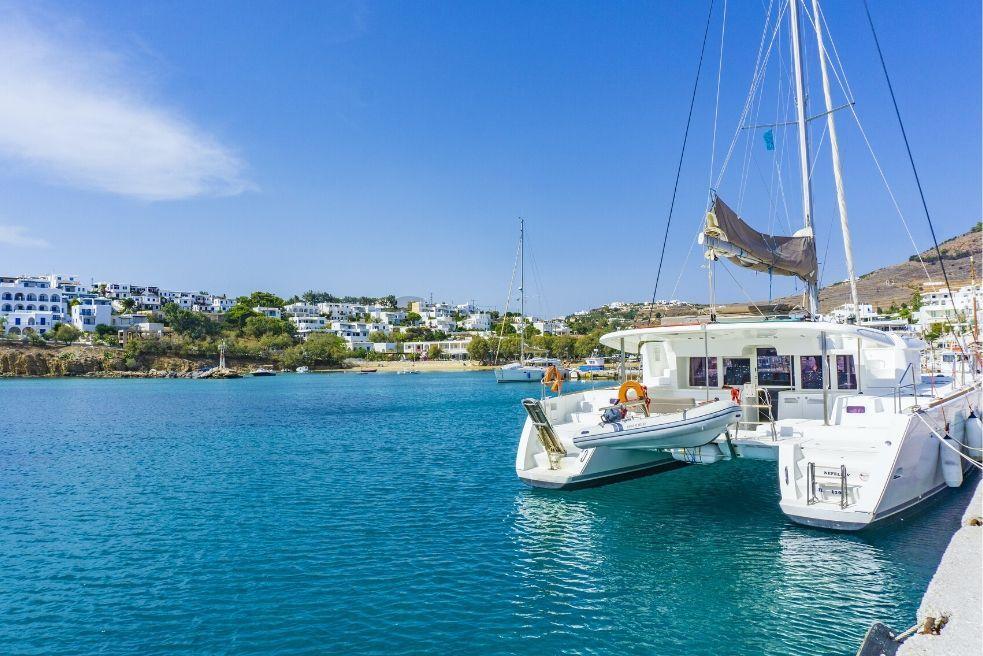
A catamaran is a boat that has two hulls. This boat can vary in size from large vessels to smaller more personal boats. As a result, catamarans are quite high in demand as anyone can find a size and price that best fits their needs.
The two hulls of the catamaran can be connected with one another through a simple frame constructed and held together by webbing. Alternatively, a more complex structure can also be used. This structure is designed as a bridge that offers extra space for cabin and cargo needs.
A catamaran is considered one of the most stable and secure vessels to travel with family and friends. In addition, catamarans also offer ample relaxation space whether on the deck as well as below. They have enough capacity to house a few rooms and multiple guests, all thanks to their double-hull .
Here are some catamaran hull characteristics you ought to know about in order to appreciate these magnificent boats:
- One of the main characteristics of a catamaran hull has to do with its performance . This is also the feature that tells these vessels apart and makes them more reliable than monohull boats. Catamaran hulls have a lower resistance when passing through water.
- In addition, a catamaran hull offers greater stability when it comes to the initial resistance to capsize.
- A catamaran hull has less volume than an equal size monohull.
- Catamaran hulls are distinguished by lighter displacement and shallower draft when compared to monohulls of the same length. As a result, catamarans can be used in shallow waters as well. This feature makes catamarans quite flexible and versatile.
- Both hulls of a catamaran work together to achieve smaller hydrodynamic resistance which is a great advantage. This feature allows catamarans to demand less propulsive power, whether from sails or engines. All in all, what this means is that a catamaran is a more economic vessel. Research conducted by the Yamaha company has shown that catamarans have a constant rise when it comes to speed and fuel burn.
- The hulls of a catamaran reduce heeling .
- Also, another characteristic of a catamaran hull is a reduced wave-induced motion which makes the boat more comfortable because it diminishes wakes.
- A catamaran has both the characteristics of a vee hull and a flat bottom hull, combined into one ingenious vessel.
If you are interested in exploring more specific features of catamarans and their hulls, have a look around TheBoatDB . This database is designed to allow anyone to search, learn, and compare boats, yachts and catamarans in greater detail.
You might like these too

Sailboat or Motorboat – Learn the pros and cons lg ...
Aug 24, 2022

Types of Catamaran Boats: Sailing, Power, and Luxury Catamarans lg ...
Feb 10, 2023

Which is better a wooden boat or fiberglass boat lg ...

What are the main types of sail rigs for sailboats lg ...

Which is the Best Economical Catamaran lg ...
Oct 04, 2021

What is a Chine on a Boat lg ...
Oct 01, 2021
Welcome to Lake
Discover places to stay and unique experiences around the world.
- How It Works
Home - Blog - Catamarans Uncovered: The Ultimate Guide to Dual-Hulled Sailing
Catamarans Uncovered: The Ultimate Guide to Dual-Hulled Sailing

David Ciccarelli
January 27, 2024
In this article
Get started.

Understanding Catamarans
When you think of sailing through turquoise seas, what comes to your mind? If you’re picturing luxurious, spacious boats that glide smoothly over water, then you’re probably thinking of catamarans. These multi-hulled marvels are not your average boats; they’re about stability, space, and speed. Let’s set sail on understanding what makes them so unique.
Catamaran Basics
Catamarans are characterized by their two parallel hulls, which fundamentally distinguish them from the traditional monohull vessels. This twin-hull design often results in a wider beam, creating an inherently stable platform. While they boast a shallower draft compared to monohulls, catamarans generally provide more living space and less heeling. With less resistance in the water, performance catamarans can achieve greater speeds. The typical displacement of these vessels means they sit on top of the water rather than plowing through it, which adds to their efficiency.
Historical Evolution
The history of the catamaran dates back thousands of years, with its roots in the fishing and transportation crafts of the ancient Polynesians. Through generations, the design has evolved from simple canoes with outriggers to the sleek, modern vessels we see today. From rudimentary construction to high-tech materials, catamarans have adapted to become a favorite in both private and commercial sectors.
Types of Catamarans
If we list out the types of catamarans, you’d encounter various classes tailored to different sailing needs. You have your cruising catamarans, spacious and comfortable, ideal for those leisurely voyages. There’s the more agile performance catamarans, designed with speed and responsiveness in mind. And then, the luxury catamarans—think of these as floating mansions, complete with opulent amenities and furnishings.
Sailing Catamarans
Your sailing catamarans are akin to dancers on water. With sails harnessing the power of the wind, these vessels are all about eco-friendly propulsion and an authentic sailing experience . Imagine gliding past coastlines without a noise except for the wind in the sails and the water against the hulls. Brands like Lagoon and Fountaine Pajot have become synonymous with this category, providing a range of options from small day sailors to majestic cruisers.
Power Catamarans
Power catamarans, as the name suggests, rely on engines for movement. These are the go-to for those who prefer a bit more oomph in their voyage—capable of higher speeds and longer range without wind dependence. They’re perfect if you’re into coastal hopping or even deep-sea adventures.
Luxury Catamarans
Indulge yourself with luxury catamarans, the epitome of elegance on the water. These vessels come with full crews, gourmet meals, and the kind of pampering you’d expect at a 5-star resort. They represent the pinnacle in comfort and amenities , often custom-designed to meet the desires of the most discerning sailors.
Let’s pause for a breath—feeling the breeze yet? Catamarans are indeed a special breed of vessels that combine innovation, comfort, and performance. So next time you dream of sailing, think of these dual-hulled wonders and consider that perhaps your next adventure awaits on board a catamaran.
Catamaran Design and Construction

Catamarans are unique in the boating world, offering stability, space, and speed that many sailors dream of. Whether you’re an enthusiast or a prospective buyer, understanding the intricacies of catamaran design and construction is essential. Have you ever wondered what goes into making these remarkable multihull vessels?
Multihull Structure
Multihull vessels, such as catamarans, are defined by their two separate hulls. This design provides natural stability which is excellent for reducing seasickness. A significant advantage here is safety ; with two hulls, even if one becomes flooded, the catamaran can often remain afloat and upright.
The Dual-Hull Design
The dual-hull design of catamarans allows for a wider beam, which translates into more deck space. When compared to monohulls, catamarans don’t heel over, making your experience onboard more comfortable and safer. This design also means less resistance when cutting through water, increasing your speed potential.
Advantages of Multihulls
Catamarans are renowned for their spaciousness and comfort, but did you know they tend to have a shallower draft? This allows you to easily explore shallower waters where other boats can’t go. Additionally, they are often faster, making them a favorite for both racing and cruising.
Materials and Construction
When building catamarans, manufacturers often utilize lightweight materials to enhance performance without compromising strength. Composites like fiberglass are common due to their durability and ease of maintenance .
Building Catamarans
The process of building catamarans involves meticulous planning and precision. Each step, from the initial design to the final touches, aims for a blend of performance and comfort. The popularity of DIY catamaran kits has also risen, catering to those who wish to take a hands-on approach to their vessel.
Composite vs. Aluminum
Catamarans can be built from various materials, but the debate often falls between composites and aluminum. Composites are prized for their strength-to-weight ratio, while aluminum is favored for its toughness and repairability. The choice depends on the intended use and the desired balance between weight and durability.
Rigging and Sails
The rigging and sails are critical in determining a catamaran’s performance. With more sail area, catamarans capture a greater amount of wind, which can improve speed. However, the sail plan must be carefully designed to balance power and handling .
Sail Configuration
Choosing the right sail configuration depends on your sailing needs. For travelers who prefer easier handling , a simple sloop rig with one mainsail and one foresail may suffice. Alternatively, performance-oriented sailors might opt for additional sails like spinnakers for downwind speed.
Sail Handling Systems
Modern catamarans incorporate advanced sail handling systems to make sailing more manageable, even for smaller crews. Features such as roller furling for the jib and lazy jacks for the mainsail simplify sail deployment and retrieval, which can be a real back saver!
So, have you gotten a clearer picture of what goes into a catamaran’s design and construction? Whether it’s the material selection or the intricacies of sail handling, each aspect plays a part in giving you the ultimate experience on the water.
Key Features and Advantages
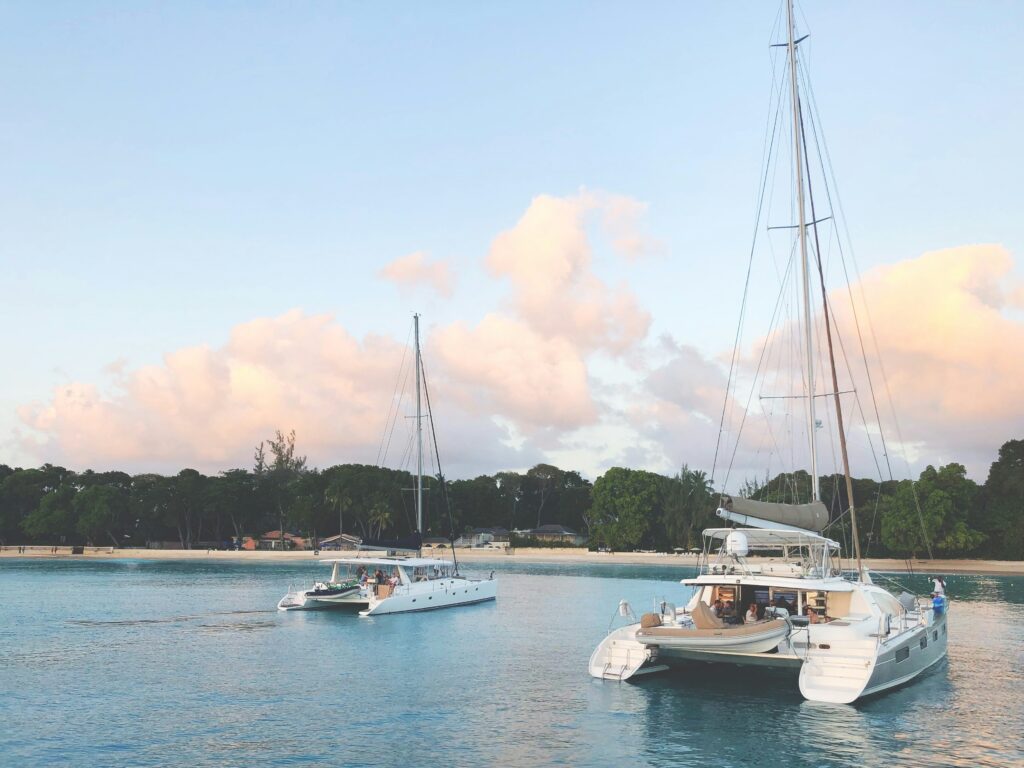
When you’re in the market for a boat that embodies comfort and performance, a catamaran is hard to beat. Let’s dive into what makes these vessels a standout choice for sailors and how they might just be your ticket to the ultimate sailing adventure.
Stability and Safety
Catamarans are renowned for their stability on the water, which translates into increased safety during your maritime excursions. Thanks to their wide beams, which can significantly exceed those of monohulls, moments of discomfort from rolling are minimized whether you’re at anchor or cutting through the waves.
Reduced Risk of Capsizing
The dual hulls of a catamaran are not just for show; they inherently provide a lower center of gravity and a wider base, which greatly decreases the odds of capsizing, giving you peace of mind as you navigate various sea conditions.
Safe Sailing in Rough Waters
One of the greatest perks of catamarans is their capability to handle rough waters with aplomb. The vessel’s design allows for quick and responsive movement, which is crucial when you’re miles from shore and conditions become challenging.
Spaciousness and Comfort
A catamaran is synonymous with spaciousness. Due to the dual hull construction, you’ll find ample living spaces comparable to a floating apartment, making long passages or entertaining guests a delightful experience.
Ample Deck Space
Have you dreamed of a boat where you can lounge, dine, and play without feeling cramped? A catamaran’s deck provides generous outdoor living areas, perfect for soaking up the sun or enjoying al fresco meals with a view of the ocean’s expanse.
Comfortable Living Spaces
Below deck, catamarans boast comfortable living quarters with enough headroom and sizeable cabins . The separation between sleeping areas, often located in different hulls, also ensures privacy that’s hard to come by in other vessel types.
Speed and Efficiency
With a sleek design and lighter weight, catamarans can glide through water quickly and with less effort. Their speed capability is not just great for thrill-seekers but also for those who wish to cover significant distances in tighter timeframes.
Fuel Efficiency in Power Catamarans
For power catamaran lovers, the efficiency game is strong. These cats are designed to consume less fuel while maintaining speed, leading to long-term savings and a reduced environmental footprint.
Ocean Cruising Capabilities
A catamaran truly shines when it comes to blue water cruising. The vessel’s stability and performance make this type of boat well-suited for exploring a variety of destinations across the globe.
Long-Distance Cruising Comfort
Planning an overnight or multi-day cruise? Catamarans are equipped to provide exceptional comfort during long-distance journeys, allowing you to reach far-off places like the Caribbean or South Pacific with ease and pleasure.
Catamarans for World Travel
Imagine setting sail to any corner of the world in a boat that feels like home. Catamarans offer that potential with their excellent cruising capabilities, capacity for provisions and fuel, and comfort—making them ideal for the adventurous sailor eager to chart a course for exotic destinations.
Remember, catamarans by brands like Lagoon or Fountaine Pajot are not only a statement of luxury but also showcase the pinnacle of marine engineering designed with your sailing lifestyle in mind. Ready to catch the wind in your sails?
Notable Catamaran Brands and Models

When you’re out on the open waters, the brand and model of your catamaran are as important as the wind in your sails. Let’s talk about some of the most revered names that have made waves in the world of catamarans.
Lagoon Catamarans
Lagoon is a French manufacturer that’s taken the catamaran market by storm. Known for a blend of innovation and tradition, these catamarans have a strong global presence.
Since its inception in 1984, Lagoon has become synonymous with high-quality catamaran craftsmanship. Their journey began as a segment of the illustrious Group Beneteau, sailing onto becoming a standalone brand admired by many.
Fountaine Pajot
Fountaine Pajot , another French marvel, has carved its niche in the luxury catamaran market since 1976, delivering elegance and sturdiness in every vessel.
Awarded multiple times, including ‘Boat of the Year’, Fountaine Pajot’s reputation is built on innovation, performance, and eco-friendly designs. They are a marquee name for discerning sailors looking for the French touch in boating excellence.
Leopard Catamarans
South African-built Leopard Catamarans offer a robust build quality and a luxury cruising experience that appeals to adventurers and comfort-seekers alike.
Leopard has consolidated its status in the catamaran domain with models like the Leopard 48, known for its innovative design and exceptional onboard amenities.
In your quest for the perfect catamaran, these brands and models stand as shining beacons of quality and expertise. Each one has a story to tell and a journey to offer, ready to make your seafaring dreams a reality. Which one will you choose for your next maritime adventure?
Choosing the Right Catamaran
When you’re on the hunt for the perfect catamaran, the choices can be as vast as the ocean itself. From understanding the key differences between sail and power options to considering your unique sailing style and budget, we’ve got the guidelines to help you navigate this significant investment.
Sail vs. Power Catamaran
Sail catamarans are beloved for their elegance and eco-friendly operation. You’re harnessed to the wind, often yielding better performance and lower operating costs. Power catamarans, on the other hand, offer more consistent speeds regardless of wind conditions and typically feature more living space.
Considering Your Sailing Style
Whether you’re dreaming of leisurely coastal cruises or ambitious ocean crossings, your sailing style is crucial. For example, a sail catamaran with a deep draft improves windward performance for long voyages, while a power catamaran might be the ticket for weekend jaunts and entertaining.
Pros and Cons of Power Catamarans
Power catamarans excel in ease of handling and spaciousness. However, they typically have higher fuel costs, so consider this when comparing prices.
Size and Capacity
Determining boat size.
The size of your catamaran impacts everything from displacement to comfort. Larger models above 40 feet can offer 5 cabins, ample deck space, and enough storage for extended cruising. However, bigger boats also mean higher costs.
Passenger Capacity and Comfort
A catamaran’s design optimally balances capacity and comfort. Here’s a quick reference:
- 2-3 cabins : Ideal for small families or couples.
- 4 cabins : Good for larger groups or charter businesses.
- 5+ cabins : Best for commercial use or those who entertain regularly.
Budget Considerations
Costs of catamarans.
The price of a new catamaran can range from a modest $200,000 to over a million dollars for luxury brands like Leopard Catamarans. Used models can bring significant savings, but factor in potential upgrade and maintenance costs.
Ongoing Expenses
Beyond the purchase price, be prepared for expenses such as docking fees, maintenance, insurance , and of course, fuel for power cats. The latter can significantly affect your budget, especially if you plan to log many nautical miles.
Finding the catamaran that suits your lifestyle, performance expectations, and budget is both an exciting and intensive process. Remember to weigh all factors carefully to ensure your final decision is one that brings endless days of joy on the water.
Maintenance and Care
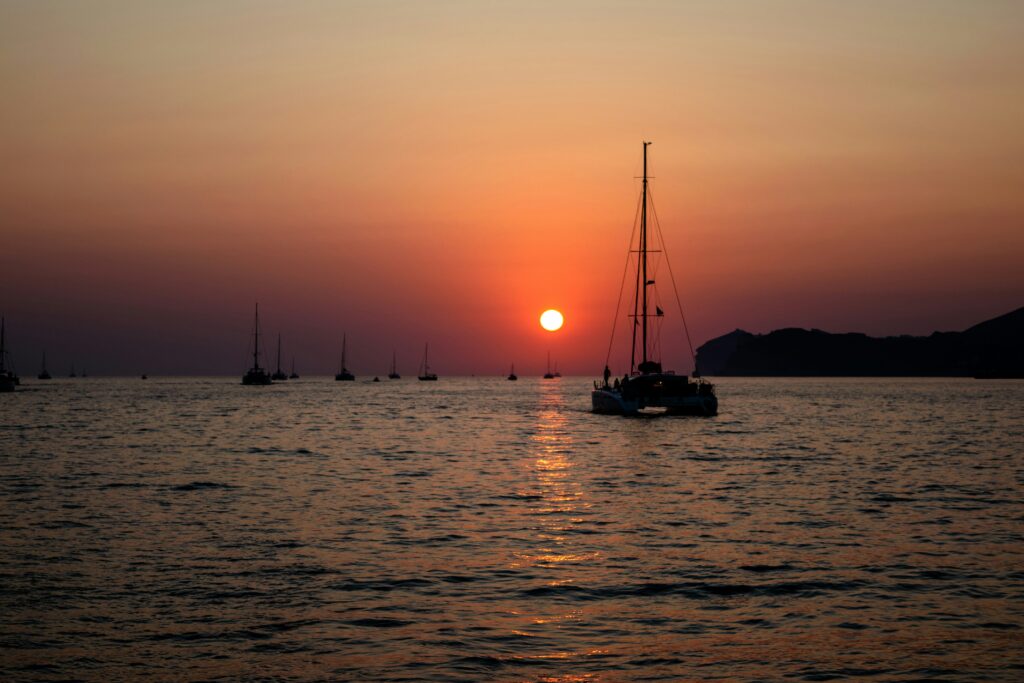
Taking care of your catamaran not only keeps it looking great but also ensures it performs optimally for years to come. Regular maintenance can prevent costly repairs and extend the life of your boat. Let’s dive right into the nitty-gritty of keeping your cat pristine, shall we?
Essential Maintenance Tasks
“Prevention is better than cure,” they say, and it couldn’t be truer for your catamaran.
- Hull Cleaning : It’s all about the smooth sail, isn’t it? Keep the hull free from marine growth with bi-annual clean-ups.
- Electrical System: Battling corrosion is like facing the high winds at sea. Keep your electrical systems corrosion-free to prevent unexpected failures.
Maintenance Schedule
Sticking to a maintenance schedule is akin to following a treasure map – it leads you to the golden prize of a well-maintained vessel. For instance, oil should be changed at least every 150 hours of engine use.
- Routine Check-Ups: Don’t forget to schedule these with the changing seasons, folks.
- Professional Inspections: Sometimes, you need a seasoned pair of eyes. Yearly check-ups by a professional can spot issues you might miss.
Cleaning and Storage
A clean and well-stored catamaran means a ready-to-go boat when sailing season hits. Nobody likes a damp surprise onboard, right?
- Dry Storage: Whenever possible, store your beloved cat on dry land.
- Cover Up: Use a high-quality cover to shield from the elements – sun, rain, or residents of the nearby trees.
Cleaning Procedures for Catamarans
This is not just a splash-and-dash affair, my friends. Take heed of these steps:
- Freshwater Rinse: After every outing, a freshwater rinse can do wonders against saltwater’s corrosive embrace.
- Mild Soaps: Use gentle cleaners like Woolite or Dawn to keep that canvas looking dapper.
Off-Season Storage Tips
The off-season doesn’t mean rest for you. It’s prime time to ensure your catamaran rests well so it’s adventure-ready when you are.
- Ventilation: Keep air circulating to thwart the ever-creeping mildew.
- Battery Care: Don’t let your batteries go flat. Keep them charged and happy during the off-season.
From the yearly varnishing to the regular freshwater rinses, keeping your catamaran in sparkling condition is a rewarding journey. It’s not just about maintaining value; it’s about cherishing the vessel that carries you across the waters, creating memories one nautical mile at a time. So grab your maintenance kit and let’s keep those cats cruising!
Sailing Safety and Regulations
Ensuring your safety while enjoying the freedom of sailing on a catamaran involves understanding and adhering to essential safety practices and boating regulations. In this section, we’ll navigate through the crucial elements of safety onboard, understand the necessary equipment, and explore the legal requirements that keep you compliant and secure at sea.
Safety Equipment on Catamarans
Catamarans must be equipped with certain safety gear. It’s imperative that your vessel has life jackets for all passengers, fire extinguishers, visual distress signals, and other USA Coast Guard approved safety equipment. Have you checked your boat’s safety inventory recently?
Safety Guidelines for Catamaran Sailing
When you’re sailing a catamaran, it’s wise to “know before you go.” This means checking weather reports and understanding your boat’s limitations. For catamaran-specific tips, remember that while daggerboards or keels enhance performance, they should be handled with care, as they affect the vessel’s stability and maneuvering.
Boating Regulations
Did you know that boating regulations can vary by state and region? It’s not just about being legally compliant; understanding these regulations helps protect the marine environment and ensures that all boaters can enjoy shared waterways safely. Have a look at the U.S. Coast Guard Boating Safety regulations to stay updated.
Adhering to Maritime Laws
Finally, respecting maritime laws and customs is not only a legal obligation but also a mark of a responsible sailor. Here’s a compelling fact: strict adherence to maritime laws significantly reduces the risk of maritime accidents. So, keep abreast of navigation rules to ensure smooth sailing.
Remember, safety is the keel that keeps the exciting adventure of catamaran sailing stable and enjoyable – make sure it’s part of your voyage every time you cast off the lines. Now, are you ready to take the helm knowing you’re well-prepared for a safe journey?
FAQs (Frequently Asked Questions)
What are the advantages of sailing on a catamaran.
You’re in for a treat with catamarans — they’re like the luxury SUVs of the sea but without the fuel guzzling. Expect sheer stability, more living space, and less heeling than a monohull.
How Much Does a Catamaran Cost?
Thought about owning one of these beauties? Keep in mind, the sticker price varies wildly. We’re talking anywhere from $100,000 for a modest pre-owned vessel to north of a couple of million for a brand-spanking-new one, outfitted for luxury. Remember to factor in maintenance costs, which can set you back a few grand a year.
Are Catamarans Suitable for Family Vacations?
Absolutely, your clan will love the spacious decks and cabins that catamarans provide. It’s like a floating condo with the best ocean views.
What Safety Equipment Should I Have on Board a Catamaran?
Your catamaran should be your safe sanctuary on the seas. So gear up with life jackets, flares, VHF radios, and a dinghy for starts. Also, a solid first-aid kit and safety harnesses are invaluable.

administrator
David Ciccarelli, is the Founder and CEO of Lake. He is based in Toronto, Canada, and is an expert in management, business administration, strategy, product development, and customer experience. His educational achievements include the Owner President Management Program at Harvard Business School (2019-2022) and the QuantumShift Program at Ivey Business School in 2017, aimed at CEOs of growing businesses.
Related Posts
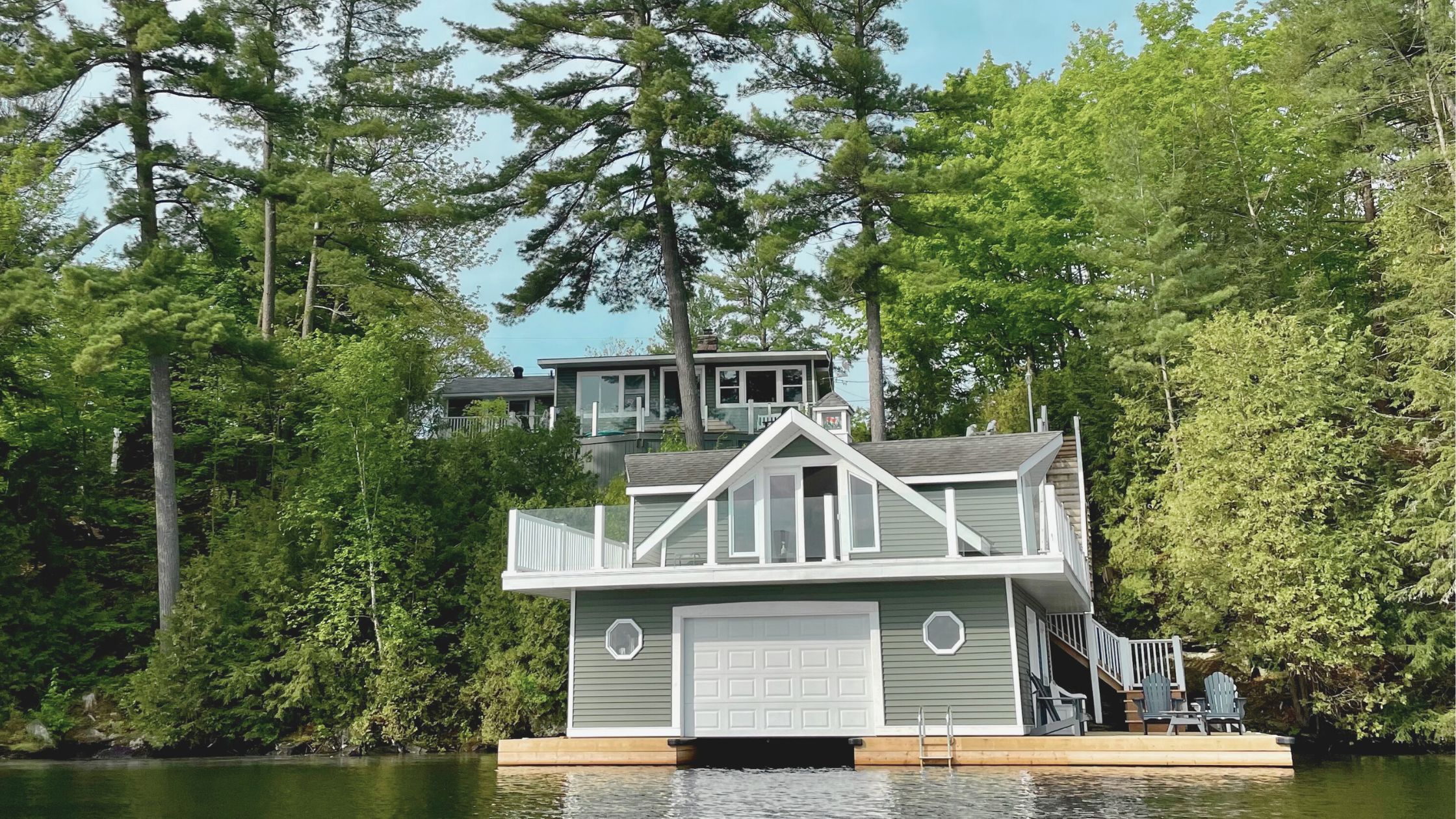
October 3, 2023
Lake House Rentals: Your Ultimate Getaway Guide for 2023
Lake houses are charming abodes that offer stunning waterfront views and bring a sense of ...

Boating: Your 10-Step Guide to Driving a Boat Safely
Boating is a fantastic way to take advantage of the great outdoors and create unforgettabl...
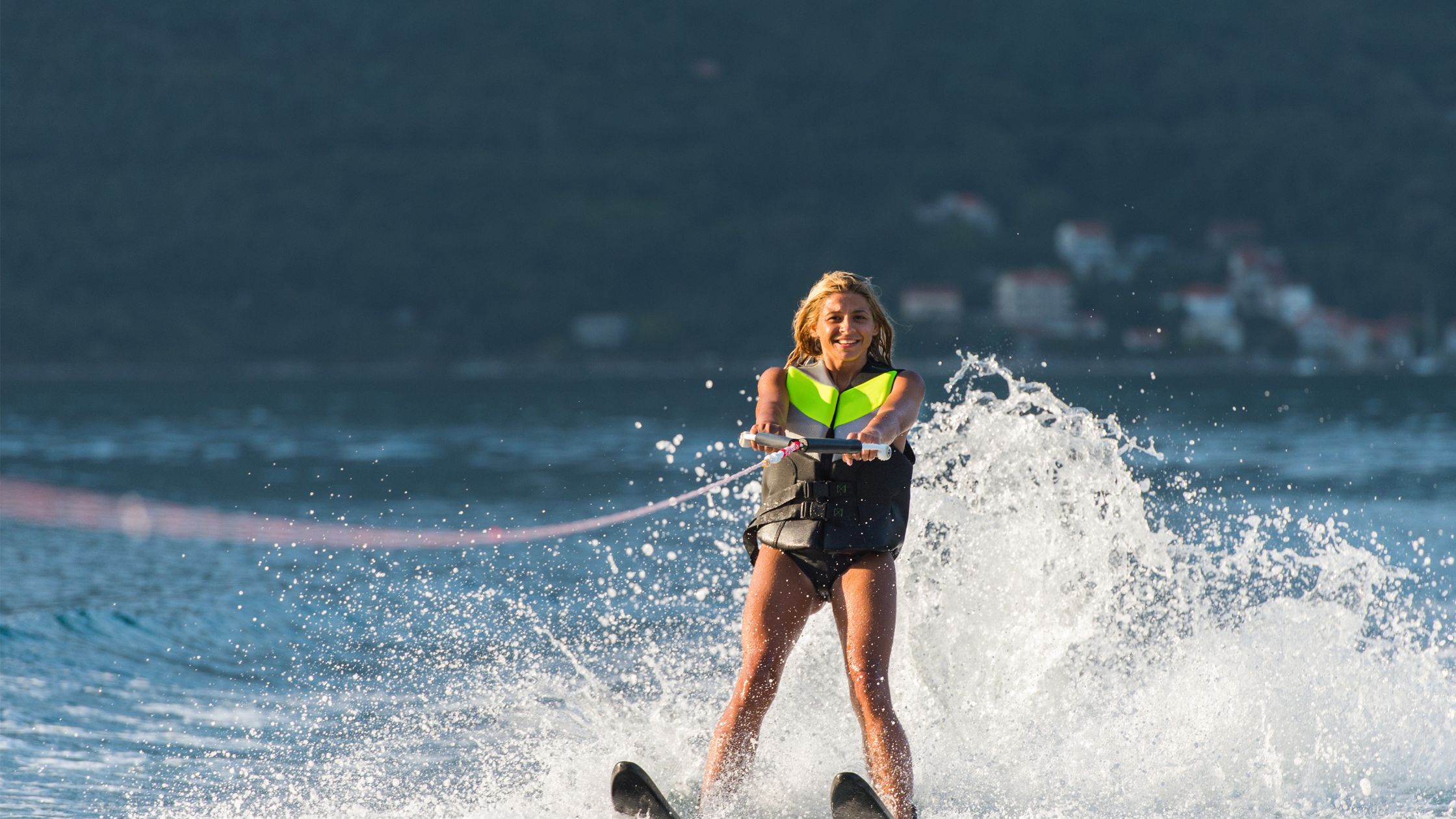
October 4, 2023
Water Skiing Essentials: Tips and Tricks for a Thrilling Experience
Water skiing is an exhilarating surface water sport where individuals ride on one or two s...
Don't have an account yet? Register
Already have an account? Sign In
Reset Password
Please enter your username or email address, you will receive a link to create a new password via email.

The Ultimate Guide to Choosing Between a Sailboat or Catamaran for Your Sailing Adventures
C hoosing between a sailboat and a catamaran for your sailing adventures is a significant decision that depends on various factors, including your sailing preferences, experience level, budget, and intended use. Here's an ultimate guide to help you make an informed decision:
1. Sailing Experience:
- Sailboats: Typically require more skill and experience to handle, especially in adverse weather conditions. Ideal for sailors who enjoy the traditional feel of sailing and are willing to invest time in learning and mastering the art.
- Catamarans: Easier to handle, making them suitable for beginners. The dual-hull design provides stability, reducing the learning curve for those new to sailing.
2. Space and Comfort:
- Sailboats: Generally have a narrower beam and less living space. However, some sailboats may offer comfortable cabins and amenities.
- Catamarans: Wider beam creates more living space. Catamarans often have multiple cabins, spacious saloons, and expansive deck areas, providing a more comfortable living experience.
3. Stability:
- Sailboats: Monohulls can heel (lean) while sailing, which some sailors enjoy for the thrill but can be discomforting for others.
- Catamarans: Greater stability due to the dual hulls, providing a more level sailing experience. Reduced heeling makes catamarans suitable for those prone to seasickness.
4. Performance:
- Sailboats: Known for their upwind performance and ability to sail close to the wind. Some sailors appreciate the challenge of optimizing sail trim for efficiency.
- Catamarans: Faster on a reach and downwind due to their wide beam. However, they may not point as high into the wind as monohulls.
- Sailboats: Typically have a deeper draft, limiting access to shallow anchorages and requiring deeper marina berths.
- Catamarans: Shallow draft allows access to shallower waters and secluded anchorages, providing more flexibility in cruising destinations.
- Sailboats: Generally more affordable upfront, with a wide range of options available to fit different budgets.
- Catamarans: Often more expensive upfront due to their size and design. However, maintenance costs may be comparable or even lower in some cases.
7. Mooring and Docking:
- Sailboats: Easier to find slips and moorings in marinas designed for monohulls.
- Catamarans: Require wider slips and may have limited availability in certain marinas, especially in crowded anchorages.
8. Intended Use:
- Sailboats: Ideal for traditional sailors who enjoy the art of sailing, racing enthusiasts, or those on a tighter budget.
- Catamarans: Suited for those prioritizing comfort, stability, and spacious living areas, especially for long-term cruising and chartering.
9. Resale Value:
- Sailboats: Generally have a more established resale market, with a wider range of buyers.
- Catamarans: Growing in popularity, and well-maintained catamarans often retain their value.
10. Personal Preference:
- Consider your personal preferences, the type of sailing you plan to do, and the kind of lifestyle you want aboard your vessel.
In conclusion, both sailboats and catamarans have their advantages and disadvantages. Your decision should be based on your individual preferences, experience level, budget, and intended use. If possible, charter both types of vessels to experience firsthand how they handle and to help make a more informed decision based on your own preferences and needs.
The post The Ultimate Guide to Choosing Between a Sailboat or Catamaran for Your Sailing Adventures appeared first on Things That Make People Go Aww .

(251) 973-0000
Request A Quote
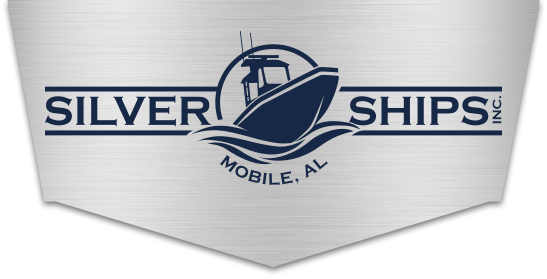
Durable, Reliable, and Versatile Workboats.
Marine Sectors
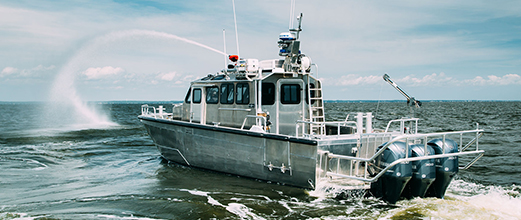
Fire/Rescue
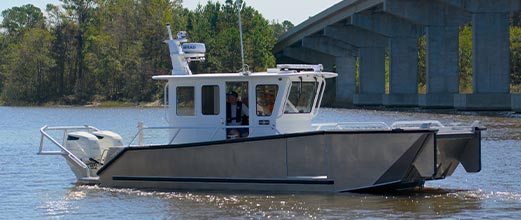
- Law Enforcement
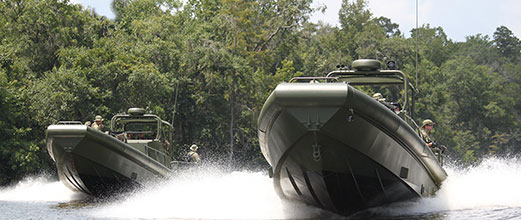
Marine Surveying
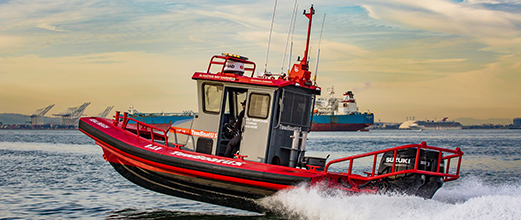
- Marine Towing
Boat Series
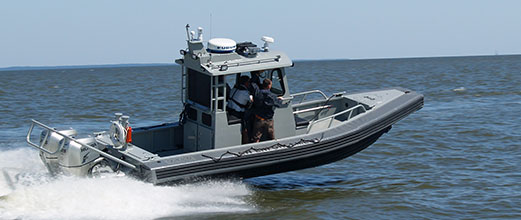
Silver Ships is a premier builder of high-quality, cutting-edge aluminum workboats used for fire rescue, law enforcement, military patrol, surveying and other applications.
For 35 years, our signature series of boats have a proven and successful track record of high quality, durability and speed, with custom options available based on customer needs.
Our special application boats are designed and built to perform at the highest level and succeed even in the most intense circumstances, no matter the mission.

Quality Boats
Our vision is to provide customers with a boat designed, built and outfitted to best suit their operational needs. we build boats that are custom designed from start to finish to meet and exceed our customers’ expectations., marine sector feature: fire rescue, silver ships fire rescue boats are designed and manufactured to accommodate individual fire-fighting and rescue missions. view our interactive fire boat edition ebook to learn more. we build boats that are custom designed from start to finish to meet and exceed our customers’ expectations..
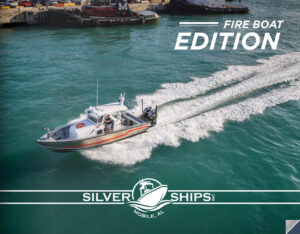
We’ll build a boat with your mission in mind.
- Fire Rescue
- Hydrographic Surveying
- Endeavor 30
- Endeavor 34
- Endeavor 45
- Endeavor 48+
- Explorer 20
- Explorer 24
- Explorer 26
- Explorer 32
- Explorer 36
- Explorer 42
- Explorer 48+
- Catamaran 26
- Catamaran 34
- Catamaran 35
- 2023 Highlights
- 2022 Highlights
- 2021 Highlights
Boats for Sale near Westlake Village, CA
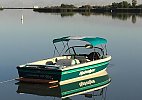

IMAGES
VIDEO
COMMENTS
If you have fine hulls you can use a lower Cp. Most monohulls have a Cp of 0.55- 0.57. And that is about right for displacement speeds. However the key to Catamaran design is you need a higher Cp if you want to sail fast. So a multihull should be at least 0.61 and a heavy displacement multihull a bit higher still.
Hulls are what sets this boat apart from the rest. The catamaran has two hulls, while the monohull, as the name suggests, has only one hull. Most of the advantages of this boat are hinged on these two hulls. The bridge deck connects the two catamaran hulls. On top of the catamaran hulls and the bridge deck is the deck.
The lightest, most expensive hulls are made from carbon, but a catamaran builder may use carbon in places other than the hull to add strength and stiffness. Carbon boards, rudders, and reinforcing structures can enhance performance without driving the price of the boat beyond reach. Carbon is the fiber of choice for many custom builds, racing ...
The pair of narrow catamaran hulls tend to experience less drag or resistance than a single wide monohull, often resulting in greater fuel economy overall for power cats and better performance for a sailing cat. Improved Seakeeping. Catamarans tend to be quite seaworthy. The knife-like hulls split waves more easily than a spoon-like monohull ...
Have you ever wondered the processes that go into Catamaran design and building a Catamaran? Maybe. Maybe not.However for those of you who are contemplating ...
Now that you've gotten the gist of it, let's look in-depth at the hull characteristics. 1. Lower Hydrodynamic Resistance. Hydrodynamic resistance of the combined two hulls is usually lower than equivalent monohulls, needing less power from the sails or the engines. A catamaran's broader posture on the water can decrease the feeling.
A catamaran rides on pair of hulls, or sponsons, each thinner and sharper than that of a similarly sized monohull boat. The narrow sponsons of the cat tend to slice easily through water to deliver a smooth ride, even in rough seas. At the same time, with the sponsons positioned out to the sides of the boat, cats tend to roll less, thus ...
Catamarans don't coast well primarily because they don't have a deep keel to track. Relying on coasting to a dock at a shallow angle and then going into reverse and using prop walk to cozy up the stern won't work. It is better to come in at a sharper angle and then pivot the boat into position with the engines.
A catamaran hull is typically characterized by its twin hulls, which are symmetrical and separated by a wide beam. These hulls are connected by a deck or a bridge, providing stability and balance to the vessel. The design of a catamaran hull allows for increased buoyancy and reduced drag, resulting in improved speed and performance on the water.
A third number that we can plug in as a constant if we want to is the prismatic coefficient which describes bow much volume there is end the ends relative to the cross section shape in the middle of the boat, but in sailing boats this is of less importance compared to other factors. The hull lines for Design 256, 8.5m Cat.
A catamaran is a twin-hull boat with two equally-sized hulls placed side by side. They're powered by engines, sails, or both—and they're known for efficiency and speed. Catamarans are the most common kind of multihull boat. In this article, we'll go over the characteristics of catamarans and how to differentiate them from other types of ...
Hulls; are what separates a cat from other sailboats, a catamaran has two hulls, a trimaran three, and a regular sailboat, aka monohull, has one. The hull is the part of the sailboat which makes it float and to where all other things are attached. The hulls are usually divided into sections, such as usable and non-usable area.
Catamaran hull resistance is determined by a number of factors, such as the shape of the hull, length and beam dimensions, wetted surface area, type of appendages, and underwater profile. To determine the resistance, the hull needs to be tested in a towing tank or in the open water. The resistance coefficients obtained by testing can then be ...
We still need to determine the beam of one hull B H1 (Figure 4). If the hulls are asymmetric above waterline this is a sum of outer hull halves. B H1 must be bigger than B WL of the hull. We'll put here in our example: B H = B H1 + B CB B H = 7.07: Now we can calculate the beam of our catamaran B H (Figure 4): Z WD = 0.06 × L WL Z WD = 0.72
Short answer: The key parts of a catamaran include the hulls, bridgedeck, mast(s), rigging, sails, rudders, and daggerboards. These components work together to provide stability, propulsion, and control for this type of multi-hulled watercraft. Exploring the Essential Parts of a Catamaran: A Comprehensive GuideFrom cruising the open seas to enjoying lazy afternoons by the shore,
A catamaran hull has less volume than an equal size monohull. Catamaran hulls are distinguished by lighter displacement and shallower draft when compared to monohulls of the same length. As a result, catamarans can be used in shallow waters as well. This feature makes catamarans quite flexible and versatile.
Catamarans are characterized by their two parallel hulls, which fundamentally distinguish them from the traditional monohull vessels. This twin-hull design often results in a wider beam, creating an inherently stable platform. While they boast a shallower draft compared to monohulls, catamarans generally provide more living space and less ...
Listed hull types include catamaran, trimaran, displacement, monohull and other. Built by a wide variety of yacht makers, there are currently 1,837 catamaran yachts for sale on YachtWorld, with 477 new vessels for sale, and 1,360 used and custom yachts listed. These vessels are all listed by professional yacht brokerages and new boat dealers ...
Type of yachts by Catamaran. This builder offers boat hull types including catamaran and planing that are generally used for traditional, time-honored activities such as overnight cruising, day cruising and sailing. Catamaran equips models listed with inboard, outboard, outboard-4s and outboard-2s drive power options, available with diesel and ...
Catamarans: Easier to handle, making them suitable for beginners. The dual-hull design provides stability, reducing the learning curve for those new to sailing. 2. Space and Comfort:
Established in 1991. Adventure Cat is a catamaran built by hand except the aluminum mast and backup engines. The boat was a combined effort between husband/wife owners Jay and Pam, and their original business partner Hans Korfin (and many helping hands along the way!). Described as "fun without fear", the Adventure Cat catamaran ensures a smoother and faster ride. From the moment you step onto ...
Boat mechanic here, I'm surprised to see a catamaran fall apart like that. The hulls below the crack house on top look professionally made. few sail boats can match catamarans in terms of interior space and ability to hold value. So it's surprising to see someone hack one up like that. Maybe that boat was a salvage at some point.
Catamaran Silver Ships is a premier builder of high-quality, cutting-edge aluminum workboats used for fire rescue, law enforcement, military patrol, surveying and other applications. For 35 years, our signature series of boats have a proven and successful track record of high quality, durability and speed, with custom options available based on ...
Saltwater Fishing. Parker. 2320 Sport Cabin. 2018. Marina Del Rey, CA. $144,000. California classified listings of boats, yachts and sailboats for sale near Westlake Village, California. Thousands of used boats from Westlake Village private parties and boat dealers in Westlake Village area.